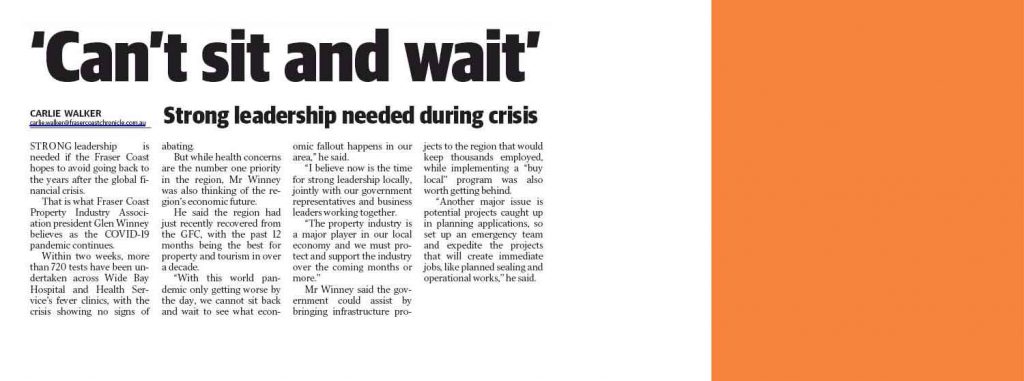The Great Christmas Sprint (and Other Modern Myths)

Somewhere around mid-December, a strange psychological switch flicks in the collective business brain. Overnight, our calendars divide into two rival codes: pre-Christmas and post-Christmas, like opposing football teams vying for the premiership. Rationally, we know the break is just three public holidays and a couple of long weekends… yet we try to cram a year’s worth of angst into about 14 days. Emails suddenly become urgent. Jobs that have sat quietly all year now must be finished “before Christmas or else”. Workloads double, patience halves, and every second sentence is, “Can’t wait for Christmas so I can have a rest” – usually muttered while staring at a to-do list breeding like rabbits. There’s clearly some psychological magic at play when the calendar ticks from 31 December to 1 January. It feels like a line in the sand, a chance to reset, even though it’s literally just… tomorrow. We act as if the world may end if the retaining wall isn’t engineered or the lease isn’t signed before Santa clocks on. The property industry never escapes the frenzy. Developers need titles, builders need sign-offs, buyers need to settle, tenants need to move in – and if it doesn’t happen pre-Christmas, apparently civilisation is at risk. Meanwhile, we battle for flights and accommodation at peak school-holiday prices, even if we don’t have school-aged kids and would happily travel in a quiet February for half the cost. Maybe the better question for all of us – as business owners, professionals and mere humans – is this: Is the pressure really worth the supposed pleasure? January still turns up. Deals still get done. Buildings still get finished. Perhaps the real Christmas miracle would be giving ourselves permission to slow down before the break… and actually arrive in the holidays with a little energy left in the tank. From all of us at FCPIA: Merry Christmas – and may your only “critical deadline” be carving the ham on time. 🎄
Have Your Say on the Future of Nikenbah & Dundowran
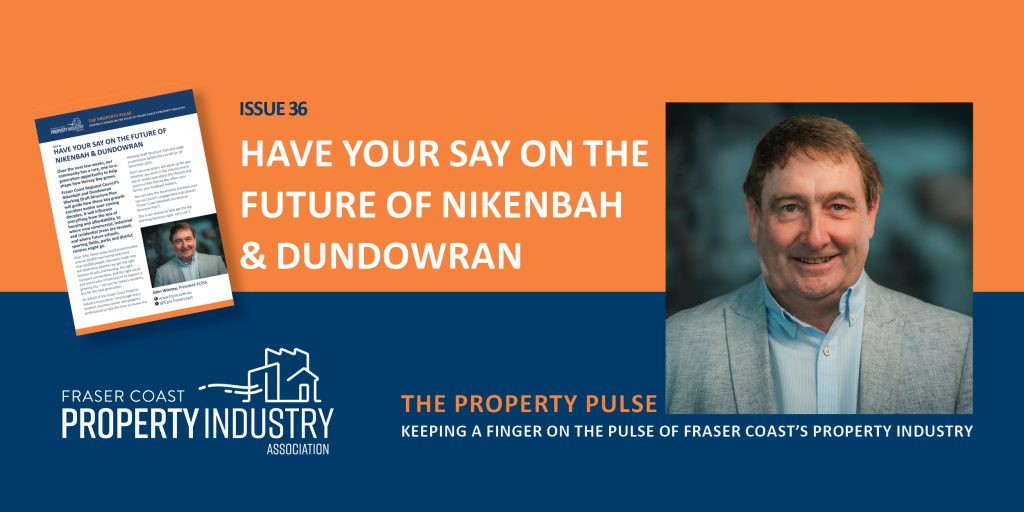
Over the next few weeks, our community has a rare, one-in-a-generation opportunity to help shape how Hervey Bay grows. Fraser Coast Regional Council’s Nikenbah and Dundowran Working Draft Structure Plan will guide how these key growth corridors evolve over coming decades. It will influence everything from the mix of housing and affordability, to where new commercial, industrial and residential areas are located, and where future schools, sporting fields, parks and district centres might go. Over time, these areas could accommodate around 20,000 new homes and more than 50,000 people. Decisions made now will determine whether we get the right balance of jobs and housing, the right transport connections, and the right social and community infrastructure to support a growing city – not just for today’s residents, but for the next generation. On behalf of the Fraser Coast Property Industry Association, I encourage every resident, business owner and property professional to take the time to review the Working Draft Structure Plan and lodge a submission before the cut-off on 19 December 2025. Don’t assume others will speak up for you. Whether you work in the industry every day or simply care about the lifestyle and opportunities Hervey Bay offers your family, your feedback matters. You can view the documents and have your say via Council’s engagement hub (search: “Fraser Coast Nikenbah Dundowran Structure Plan”). This is our chance to help get the big planning decisions right. Let’s use it.
Who Are We Building For? (Now—and 10 Years From Now)
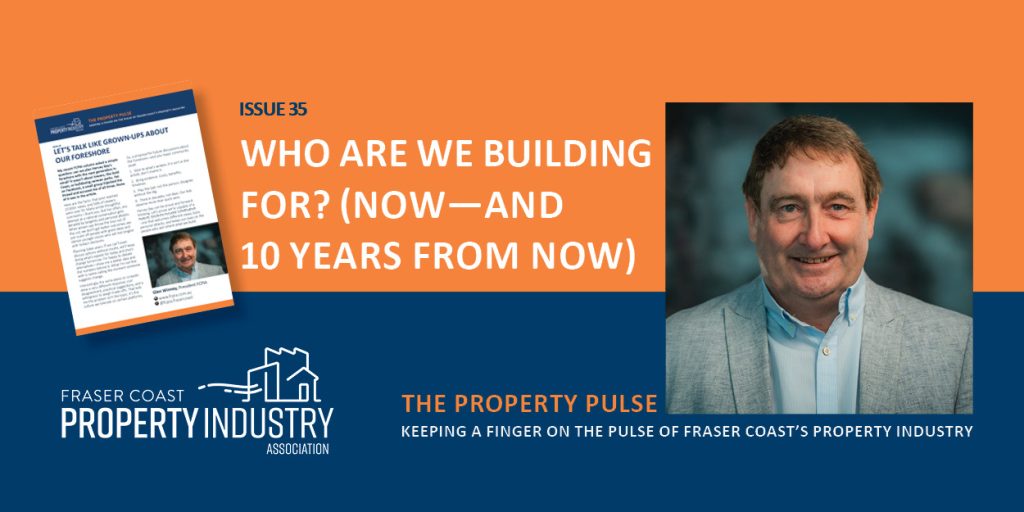
Here’s the question we keep dodging in housing debates: Who is the end user—today and in a decade? What we approve now lasts 50+ years. If we keep designing for yesterday’s buyer because “the stats say it worked,” we lock tomorrow’s Fraser Coast into yesterday’s shape. We’re good at producing what we already know: over-55s lifestyle villages and large houses on large blocks. But look at the demographic runway: constrained land supply, an affordability crunch, and an ageing population. Within the next decade, a big share of our current workforce will retire. To care for our community—and power local businesses—we’ll need an influx of 25–40 year-old workers and young families, especially in health and allied services. If they can’t find the right homes near the right amenities at the right price, they won’t come—or won’t stay. So let’s plan for tomorrow’s housing today and grow into it. That means more choice at a human scale: small lots, duplexes, terrace rows, walk-ups over shops, and well-managed apartments—close to transport, schools, parks, clinics, and everyday retail. It means neighbourhoods that are greener, more walkable, and more flexible for changing family shapes and work patterns. The proposal is simple: adopt a User-Lens Checklist for every Development, Council & State decision and DA application. Three questions, every time: If a project can’t point to “yes” for at least two of the three, why are we building it? Let’s stop planning today with yesterday’s mirror. Build for the people we need next—so the Fraser Coast we love can actually function, care, and prosper.
Let’s Talk Like Grown-Ups About Our Foreshore
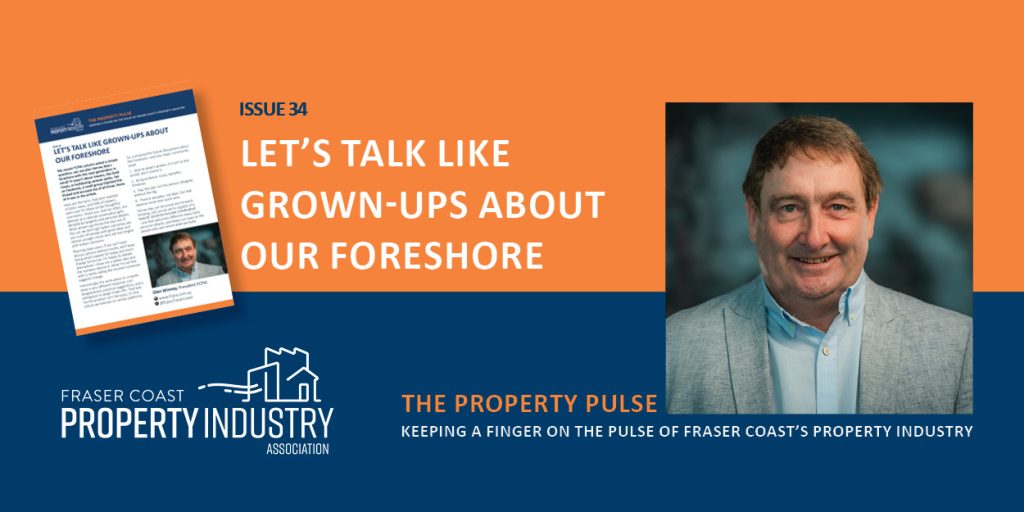
My recent FCPIA column asked a simple question: can we plan Hervey Bay’s foreshore with the next generation in mind? It wasn’t about towers, the Gold Coast, or bulldozing caravan parks. Yet on Facebook, a small group hijacked the thread and accused me of all three. None of it was in the article. Here are the facts: that post reached 27,000+ views, and 56% of viewers were over 55. Many wrote thoughtful comments—thank you. But too often, any attempt at a rational conversation gets derailed by tangents and personal attacks. When grown-ups throw the toys out of the cot, we don’t get better outcomes; we just scare off people with good ideas and silence younger voices who will live longest with today’s decisions. Planning takes years. If we can’t even discuss options without insults, we’ll keep doing what’s easiest for today and short-change tomorrow. I’m happy to debate alternatives—show me a better idea and the numbers behind it. What I’m not fine with is name-calling the moment someone suggests change. Interestingly, the same piece on LinkedIn drew a very different response: civil disagreement, practical suggestions, and a willingness to weigh trade-offs. That tells me the problem isn’t the topic; it’s the culture we tolerate on certain platforms. So, a proposal for future discussions about the foreshore—and any major community asset: Hervey Bay can be proud and forward-thinking. Let’s prove we’re capable of a mature, solutions-focused conversation—one that welcomes different views, bans personal attacks, and keeps our eyes on the people who will inherit what we build.
Hervey Bay Foreshore – proud… but are we falling behind?

Hervey Bay’s esplanade, calm beaches, Urangan Pier and WetSide Water Park are assets most cities would envy. Families stroll, cyclists roll, and every winter the whales put us on the map. But look at our peers: Cairns built a lagoon-led precinct that anchors its visitor economy; Townsville’s Strand remains a multi-generational magnet for play, exercise and events; Yeppoon’s free lagoon and amphitheatre rebranded the town almost overnight; Airlie Beach rebuilt with markets, a foreshore stage and a true day-into-night vibe. So, a fair question: are we getting left behind—especially on youth appeal and the evening economy? What we do well: safe, scenic movement (walk/cycle), family-friendly parks, and an authentic village character tied to nature. What we can do better: deliver a signature, all-ages drawcard (lagoon or equivalent); program regular markets, music and pop-up sport to keep people on the foreshore after sunset; lift wayfinding, lighting and public art; expand shaded play, skate and active zones (pump track, outdoor courts, learn-to-ride loops); and curate a waterfront dining spine that hums year-round. Why this matters now: our older population rightly drives strong demand for health services—about 21% of local jobs are in health and care—but that makes attracting younger workers and young families mission-critical. To staff hospitals, clinics, schools, hospitality and tech, we must offer the lifestyle infrastructure they choose: lively public spaces, free recreation, events, and places to gather after work. My view: we don’t need another plan—we need a mindset change. Let’s move from “protect and preserve only” to “protect and activate.” Back one catalytic project, say yes to small weekly activations, and hold ourselves to a higher standard of cleanliness, lighting, and maintenance. If we want youth, skills and investment, our foreshore must signal momentum: energy after dark, things to do every weekend, and a hero attraction that says “stay another day.” In five years, will our esplanade still be lovely—or truly unforgettable to the next generation we need to attract and keep? That choice starts with our mindset.
Emotional Intelligence: The Edge Fraser Coast Can’t Afford to Ignore
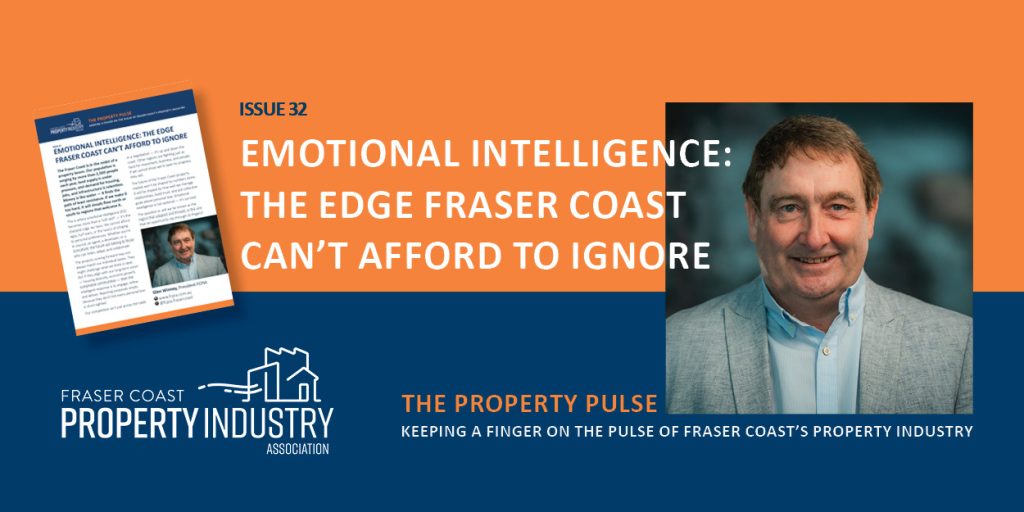
The Fraser Coast is in the midst of a property boom. Our population is surging by more than 2,500 people each year, land supply is under pressure, and demand for housing, jobs, and infrastructure is relentless. Money is like water — it finds the path of least resistance. If we make it too hard, it will simply flow north or south to regions that welcome it. This is where emotional intelligence (EQ) becomes more than a “soft skill” — it’s the sharpest edge we have. We cannot afford egos, turf wars, or the luxury of clinging to personal preferences. Whether you’re in council, an agent, a developer, or a consultant, the future will belong to those who can listen, adapt, and collaborate. The projects coming forward may not always match our individual tastes. They might challenge what we think is ideal. But if they align with our long-term vision — housing diversity, economic growth, sustainable communities — then the intelligent response is to engage, refine, and deliver. Rejecting proposals simply because they don’t tick every personal box is short-sighted. Our competition isn’t just across the table in a negotiation — it’s up and down the coast. Other regions are fighting just as hard for investment, business, and people. If we cannot show we’re open to progress, they will. The future of the Fraser Coast property market won’t be shaped by numbers alone. It will be shaped by how well we manage relationships, build trust, and put collective goals above personal bias. Emotional intelligence is not optional — it’s survival. The question is: will we be known as the region that adapted and thrived, or the one that let opportunity slip through its fingers?
Property Is About People
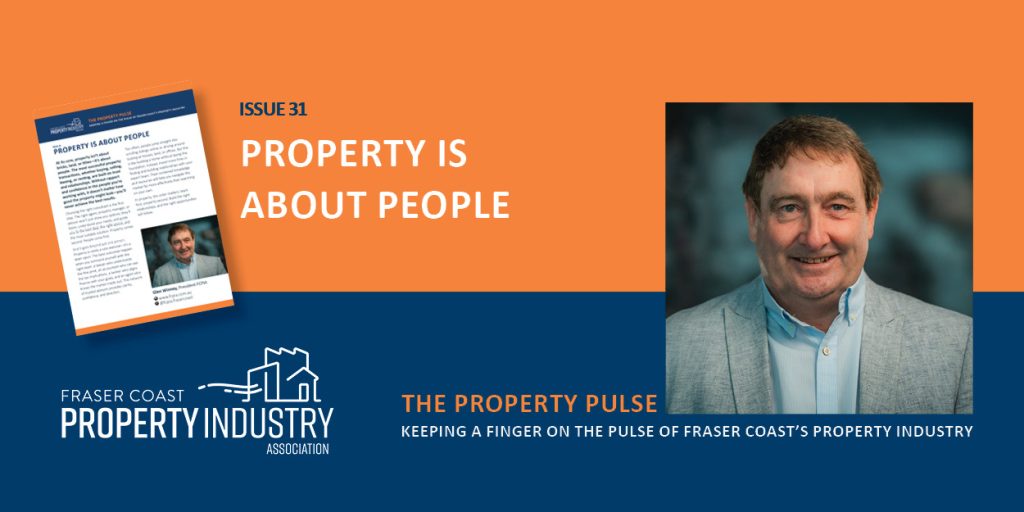
At its core, property isn’t about bricks, land, or titles—it’s about people. The most successful property transactions, whether buying, selling, leasing, or renting, are built on trust and relationships. Without rapport and confidence in the people you’re working with, it doesn’t matter how good the property might look—you’ll never achieve the best results. Choosing the right consultant is the first step. The right agent, property manager, or advisor won’t just show you options; they’ll listen, understand your needs, and guide you to the best deal, the right advice, and the most suitable solution. Property comes second. People come first. And it goes beyond just one person. Property is rarely a solo exercise—it’s a team sport. The best outcomes happen when you surround yourself with the right team: a lawyer who understands the fine print, an accountant who can see the tax implications, a banker who aligns finance with your goals, and an agent who knows the market inside out. This network of trusted advisors provides clarity, confidence, and direction. Too often, people jump straight into scrolling listings online or driving around looking at houses, land, or offices. But this is like building a home without laying the foundation. Instead, invest more time in finding and building relationships with your expert team. Their combined knowledge and resources will help you navigate the market far more effectively than searching on your own. In property, the order matters: team first, property second. Build the right relationships, and the right opportunities will follow.
Technophiles vs Luddites: The Great Property Divide
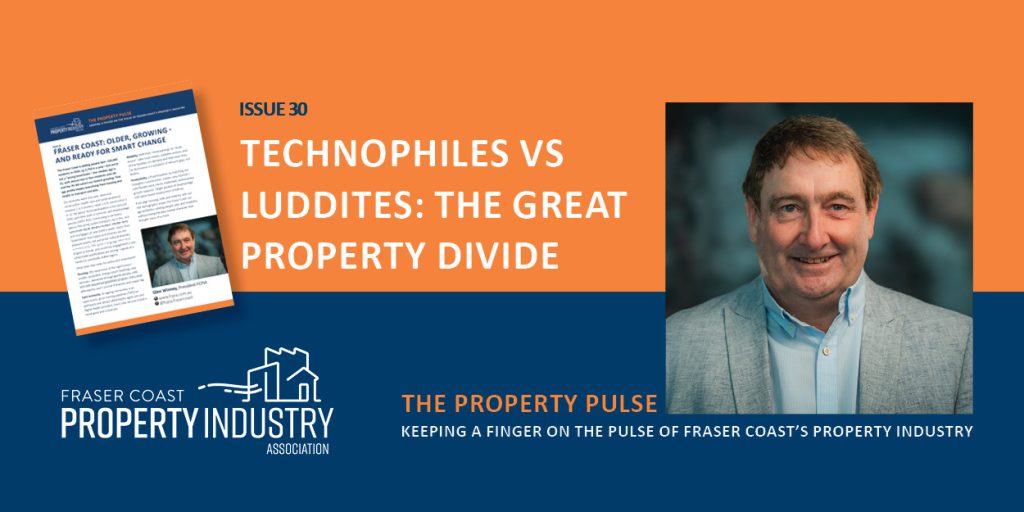
After 40-odd years in the property industry, I can’t recall a bigger divide than the one I’ve seen emerging over the last two years. It’s not about land supply or headworks charges this time — it’s about technology. And on the Fraser Coast, the property world now has two clear camps: the Luddites and the Technophiles. On one side, you’ve got the Luddites: the “we’ve always done it this way” crowd. They shuffle their papers, sharpen their pencils, and mutter darkly about the dangers of change. AI? “Too risky.” Digital tools? “Not accurate.” ChatGPT? “That’s cheating!” Their answer to progress is to double down on tradition — even if it means their systems creak louder than an old fax machine on dial-up. Then there are the Technophiles. This camp straps in like it’s a drag race at 100 miles an hour, grabbing every new app, AI tool, and platform that promises to make business faster, smarter, or more efficient. To them, ChatGPT isn’t a threat, it’s one of the greatest efficiency tools in decades. These folks are building workflows, generating insights, and finding ways to do in minutes what used to take days. The fun part? We’ve seen this movie before. Back in the early 1800s, the Luddites smashed the new textile machines to save their jobs. But history wasn’t on their side — technology marched on, and the world left them behind. So here’s the big question for the Fraser Coast property industry — from agents and lawyers to planners, surveyors, and builders: which camp will you pitch your tent in? Because like it or not, the future isn’t waiting. And if history’s any guide… we all know what happened to the Luddites.
AI and the Property Game: Hervey Bay’s Next Five Years
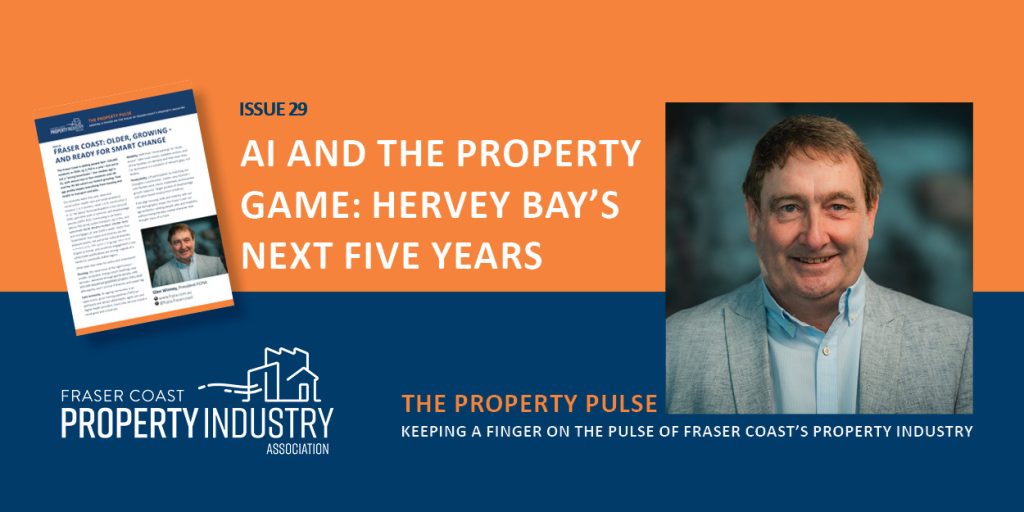
Hervey Bay’s property market is already under pressure—population growth is running ahead of housing supply, approvals are slow, and affordability is slipping. Now, artificial intelligence (AI) is about to step in and change the rules. The question is: are we ready? AI can already crunch data faster than any consultant. Imagine planning approvals that take weeks instead of months, valuations that update in real time, or chatbots answering tenant calls at midnight. By some estimates, a third of all property management and admin tasks could be automated within five years. That means fewer headaches for landlords and councils—but also a serious rethink of where the human jobs sit. It’s not just management. In planning, AI can read through thousands of public submissions and spit out summaries in hours. In construction, it can detect design flaws before a brick is laid. And in sales, predictive tools will help builders and agents know exactly which product types buyers want before they even hit the market. But let’s not kid ourselves—buyers still need trust. No algorithm can shake your hand at an open home or calm your nerves before settlement. The human factor will stay, but the way we work will change. For Hervey Bay, this shift could be a chance to get ahead. If our council, industry, and community lean into AI now—training staff, modernising planning systems, and setting clear rules—we could speed up supply and create smarter housing options. If we ignore it, we risk being left behind. So here’s the debate: will AI be the tool that unlocks better housing for the Fraser Coast—or another shiny toy that leaves us arguing while the shortage grows?
Have We Lost the Art of Debate?
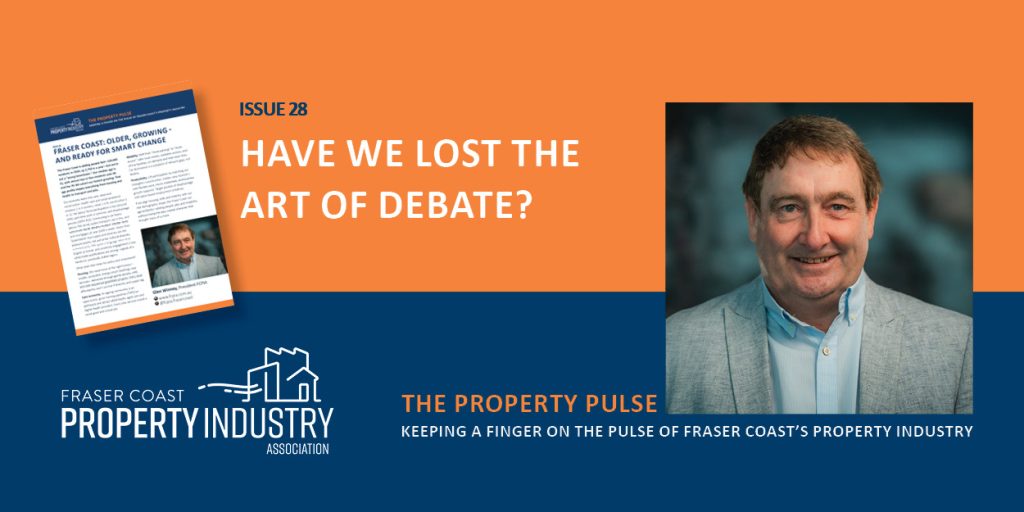
Freedom of opinion has always been a cornerstone of democracy. Yet in recent times — from Australian marches, politicians being demoted, tragic shootings in the US, to our very own public debates on Facebook — it feels like genuine debate has been replaced with shouting matches and personal attacks. Social media in particular has amplified division, where differing views are often “howled down” rather than discussed. Why does this matter to the property industry and Hervey Bay? Because if we want a bright future for our region, we need to create space for real conversation. Progress comes from open debate, the sharing of ideas, and the courage to think outside the box. When people are too afraid to voice fresh perspectives, we lose the chance to innovate. Hervey Bay is filled with talented people from across Australia and the world, many of whom have seen better planning, smarter infrastructure, and more successful approaches elsewhere. Yet too often they stay quiet, wary of being attacked personally instead of having their ideas debated on merit. This silence comes at a cost. NIMBYism (Not In My Backyard) is alive and well, and while everyone has a right to their say, shutting down change simply because it challenges personal preferences prevents good planning, better housing, and new jobs. Yes, there will always be projects we don’t like — but the bigger picture isn’t about the individual. It’s about what’s best for the region as a whole, for economic growth, and for the generations that will come after us. If we can restore the art of respectful debate, Hervey Bay will be better placed to shape a future that balances vision, progress, and community needs.
Retail Isn’t Dead – It’s Booming in Hervey Bay
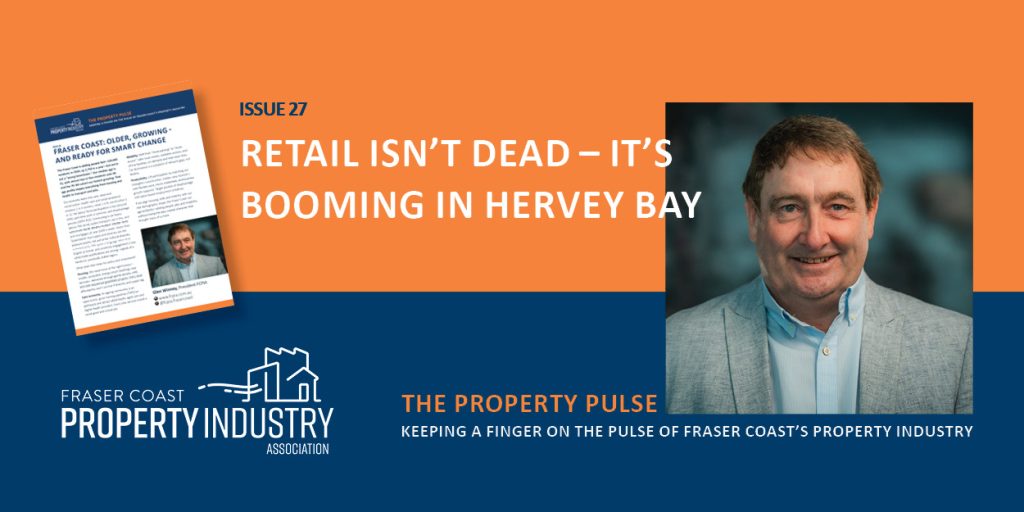
At the Fraser Coast Property Industry Association, we often hear the national headlines declaring “retail is dead.” In Hervey Bay, the opposite is true – retail is not just alive, it’s thriving and expanding faster than ever. The most visible change has been the surge in big-box retailing. The massive new Bunnings Warehouse has set a benchmark in scale and investment, drawing customers from across the region. Meanwhile, the old Bunnings site has been completely revitalised, now home to a line-up of national brands including Amart Furniture, Rebel, BCF, and more – proof that one retailer’s move has unlocked opportunity for many others. That momentum hasn’t stopped there. The new Anaconda centre has landed with strength, and alongside it, major brands such as Harris Scarfe and The Good Guys have expanded the retail mix, cementing Hervey Bay’s position as a regional shopping hub. On Main Street, new retail spaces are under construction, offering flexible formats for a new generation of businesses and creating further confidence in the Fraser Coast market. Yes, online shopping is here to stay – but in Hervey Bay, bricks-and-mortar retail is adapting, not retreating. From national operators to local lifestyle businesses, the shift is toward offering experience, convenience, and a reason to visit. Our community still wants to shop, dine, and gather in person – and they are doing so in ever-growing numbers. For landlords, tenants, and developers, the lesson is clear: retail in Hervey Bay isn’t dying; it’s transforming into something stronger. With population growth, lifestyle demand, and major national investment flowing in, the Fraser Coast is entering a new era of retail success. FCPIA: Championing growth, shaping opportunity, and backing the future of Fraser Coast retail.
Fraser Coast: older, growing – and ready for smart change
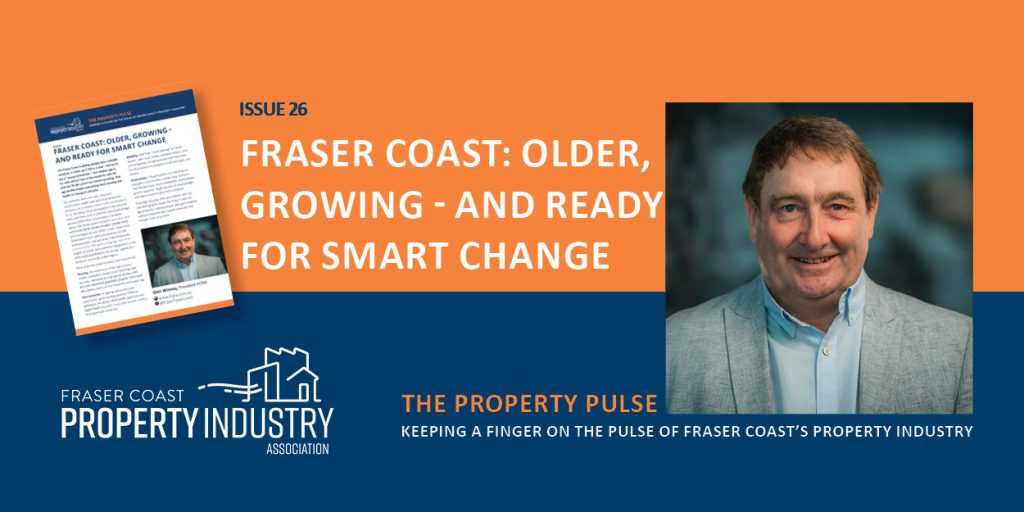
The Fraser Coast is adding people fast—120,685 residents in 2024, up 2,750 in a year—but we’re not a “young boomtown.” Our median age is 51, with almost two in five residents over 60 and the 70–84 cohort our fastest-growing. That age profile shapes everything from housing and health to transport and jobs. Our economy leans into care, retail and construction: health care and social assistance employs 1 in 5 workers, retail 1 in 9, construction 1 in 11. Yet labour force participation is low (around 44%), part-time work is common, and disadvantage persists (SEIFA 915). Commuting is car-heavy (about 74% drive), public transport use is tiny, and work-from-home remains modest. Median rents and mortgages sit near $300 a week—lower than Queensland—but supply and diversity are the pressure points, not just price. Cultural diversity is limited (only ~4% speak a language other than English at home), and university engagement is low, while trade qualifications are strong—signals of a hands-on, practically skilled region. What does that mean for policy and investment?Housing. We need more of the right homes—smaller, accessible, energy-smart dwellings near services—delivered through gentle density, infill, and well-sequenced greenfield projects. Entry-level affordability won’t survive if diversity and supply lag. Care economy. An ageing community is an opportunity: grow training pipelines (TAFE/uni pathways) and attract allied health, aged care and digital-health providers. Every new service is both a social good and a local job. Mobility. Shift from “more parking” to “more access”: safer local streets, walkable centres, end-of-trip facilities, on-demand and inter-town links. Car dominance is a symptom of network gaps, not destiny.Productivity. Lift participation by matching our strengths—construction, trades, care, tourism—with flexible work, micro-credentials, and business growth supports. Target pockets of disadvantage with place-based employment initiatives. If we align housing, skills and mobility with our real demographic shape, the Fraser Coast can age brilliantly—adding people, jobs and liveability without losing the easy coastal character that brought many of us here.
Hervey Bay 2046: A Growing City with a Promising Future

When I first presented growth forecasts to the Chamber over a year ago, I emphasised that the Fraser Coast’s future would be far bigger than many were planning for. The figures remain compelling, and they show both the challenge and the enormous opportunity before us. By 2046, the Fraser Coast is projected to welcome around 55,000 new residents—an increase of nearly 50% in just two decades. That’s the equivalent of adding another Maryborough to our region every 20 years. Importantly, the majority of this growth will be centred along the coast, with Hervey Bay as the dominant driver. To accommodate it, we’ll need approximately 1,200 new homes each year, yet current frameworks are only planning for about 700 annually. That gap—close to 19,000 homes by 2046—is not a crisis if we act now, but rather a chance to rethink how and where we build. Growth on this scale doesn’t just mean more houses. It means a larger workforce, stronger local businesses, and the ability to attract investment and infrastructure that would never come to a smaller community. But for this to happen, our planning needs to shift gears—embracing housing diversity, infrastructure upgrades, youth retention, and a long-term vision that balances lifestyle with opportunity. The Fraser Coast is blessed with natural beauty, lifestyle appeal, and a strong sense of community. If we get our thinking right today, these 55,000 new residents will not be a strain—they’ll be the energy that drives a new era of prosperity. It’s worth pausing to reflect: the decisions we make now will determine whether growth is something we react to, or something we harness to create a brighter, balanced future for the next generation.
Is Car Parking the Silent Crisis?

Hervey Bay has grown from a sleepy town of 16,000 in early 1980’s to a thriving regional city of over 68,000 in just four decades—an extraordinary 4.12x increase, averaging over 3% per annum. Yet one issue has been consistently overlooked in our city’s planning: car parking. Despite this explosive growth, we’ve seen little investment in solving the transport and parking challenges that come with it. In fact, the infrastructure we had was systematically dismantled—railway lines pulled out, the iconic Urangan Pier shortened to prevent ship access, and our road network left to lag behind population demand. Today, SUVs dominate our driveways, and public transport is scarcely a viable alternative for most residents – particularly for our ageing population, who need access to medical services and social activities. Meanwhile, car parks are not just failing to keep up—they’re shrinking. New developments, especially medical centres, often struggle to provide enough parking for staff, let alone patients. Along the Esplanade, we’ve added hundreds of new dwellings and businesses, but no real parking strategy. If anything, we’ve lost spaces over time. There’s been no serious move to acquire or repurpose low-lying land a block back for overflow parking. Instead, we squeeze more activity into areas with limited capacity. At the hospital precinct—our region’s most critical health hub—we’re building up around inadequate parking and minimal transit links, making access harder just when it should be easiest. It’s time we asked: What’s the actual plan? Are we serious about solving this, or just hoping it sorts itself out? We need a bold rethink: major investment in public transport, and strategic land acquisition for multilevel carparks in key precincts. Without it, we risk turning growth into gridlock. What do you think—do we need a parking revolution?
What Do We Want to Be Known For? Hervey Bay’s Identity Crisis
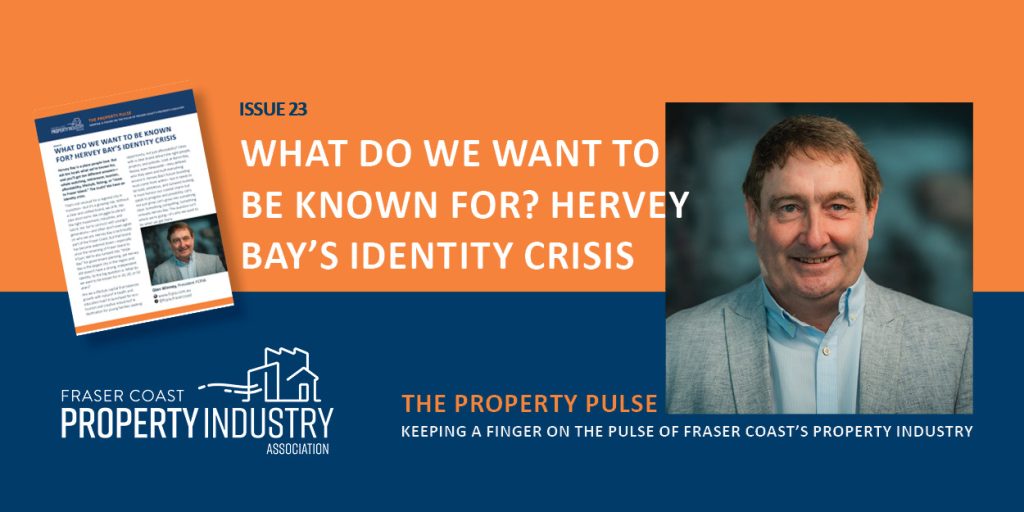
Hervey Bay is a place people love. But ask ten locals what we’re known for, and you’ll get ten different answers—whale watching, retirement, tourism, affordability, lifestyle, fishing, or “close to Fraser Island.” The truth? We have an identity crisis. That’s not unusual for a regional city in transition—but it’s a growing risk. Without a clear and unified brand, we drift. We plan short-term. We struggle to attract the right investment, industries, and talent. We fail to connect with younger generations—and often don’t even agree on who we are. Hervey Bay is technically part of the Fraser Coast, but that brand has become watered down—especially since the renaming of Fraser Island to K’Gari. We’re also lumped into “Wide Bay” for government planning, yet Hervey Bay is the largest city in the region and still doesn’t have a strong, independent identity. So the big question is: What do we want to be known for in 10, 20, or 50 years? Are we a lifestyle capital that balances growth with nature? A health and education hub? A launchpad for eco-tourism and creative industries? A destination for young families seeking opportunity, not just affordability? Cities with a clear brand attract the right people, projects, and policies. Look at Byron Bay, Noosa, even Newcastle—they defined who they were and built everything around it. Hervey Bay’s future branding must come from within—but it needs to be bold, ambitious, and outward-looking. It must honour our coastal charm but speak to progress and possibility. Let’s not just grow. Let’s grow into something clear. Something compelling. Something uniquely Hervey Bay. The question isn’t where we’re going—it’s who we want to be when we get there.
Gentle Density – Hervey Bay’s Key to a Smarter, More Livable Future
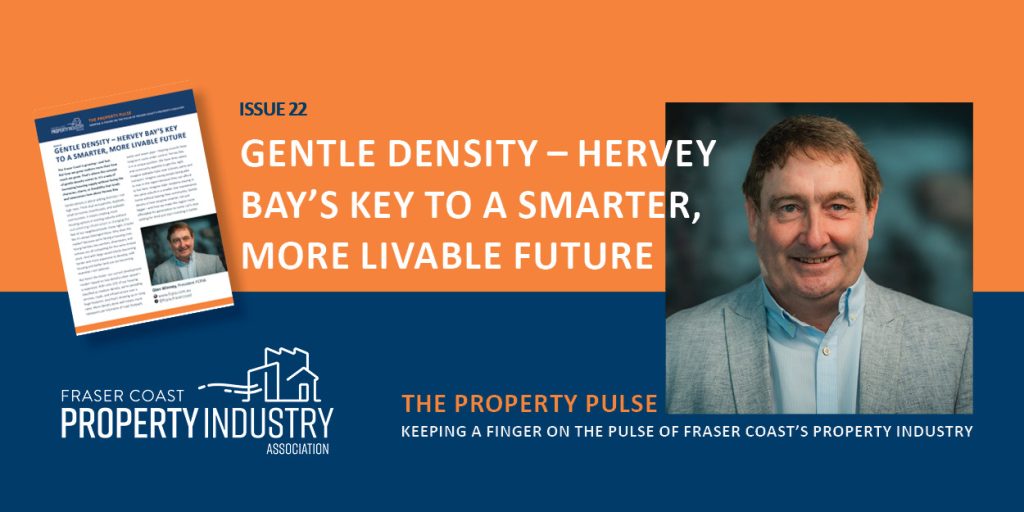
The Fraser Coast is growing—and fast. But how we grow matters more than how much we grow. That’s where the concept of gentle density comes in. It’s a way of increasing housing supply without losing the character, charm, or liveability that locals and newcomers love about Hervey Bay. Gentle density is about adding diversity—not high-rises. Think dual occupancies, duplexes, small lot homes, townhouses, and walkable communities. It means creating more housing options in existing suburbs without overwhelming infrastructure or changing the feel of our neighbourhoods. Done right, it looks like it’s always belonged there. Why does this matter? Because we’re facing a housing crisis. Young families, key workers, downsizers, and retirees are all competing for the same limited stock. And with large vacant blocks becoming harder and more expensive to develop, infill housing and better land use are becoming essential—not optional. But here’s the kicker: our current development model—based on low-density urban sprawl—is expensive. With only 12% of our housing classified as medium density, we’re spreading services, roads, and infrastructure over a huge footprint. And that’s showing up in rising rates. More density done well means more ratepayers per kilometre of road, footpath, water and sewer pipe—helping councils keep long-term costs under control. Hervey Bay is in a unique position. We have time, space, and community appetite to get this right. Imagine walkable hubs near schools, parks and transport. Imagine young people being able to stay in the region because they can afford to live here. Imagine older residents staying in the same suburb in a smaller, low-maintenance home without leaving their community. Gentle density is how we grow smarter, not just bigger—and how we make this region more affordable for generations to come.
Why the Fraser Coast Needs a 50-Year Vision – Not a 5-Year Budget
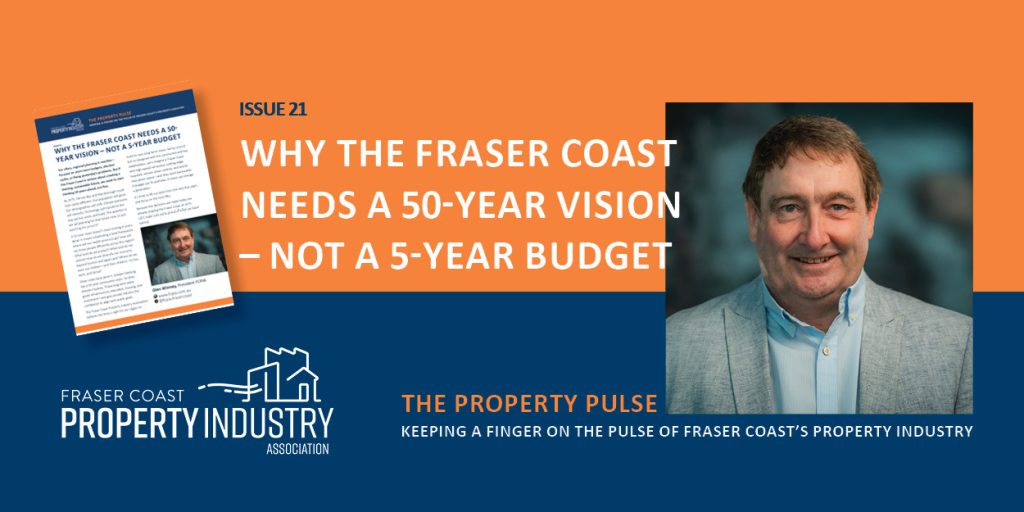
Too often, regional planning is reactive—focused on short-term budgets, election cycles, or fixing yesterday’s problems. But if the Fraser Coast is serious about creating a thriving, sustainable future, we need to start thinking 50 years ahead, not five.By 2075, Hervey Bay and Maryborough could look vastly different. Our population will grow. Our demographics will shift. Climate pressures will intensify. Technology will transform the way we live, work, and build. The question is: are we planning for that future now, or just patching the present? A 50-year vision doesn’t mean locking in every detail. It means establishing a bold framework: where will our health precincts go? How will we move people efficiently across the region? What land do we protect? What land do we unlock? How do we diversify our economy beyond tourism and aged care? Where do we want our children—and their children—to live, work, and thrive? Other cities have done it. Greater Geelong has a 50-year community vision. So does Western Sydney. These long-term plans guide infrastructure, education, housing, and investment—and give private industry the confidence to align with public goals. The Fraser Coast Property Industry Association believes the time is right for our region to build its own long-term vision, led by council but co-designed with the community and key stakeholders. Let’s imagine a Fraser Coast with high-speed rail access, cutting-edge hospitals, vibrant urban centres, and world-class green space—and then work backwards. A budget can fix potholes. A vision can change a generation. It’s time to lift our eyes from the next five years and focus on the next fifty.Because the decisions we make today are already shaping the Fraser Coast of 2075. Let’s make sure we’re proud of what we leave behind.
Housing for Who? Why We Need More Than Just Big Blocks
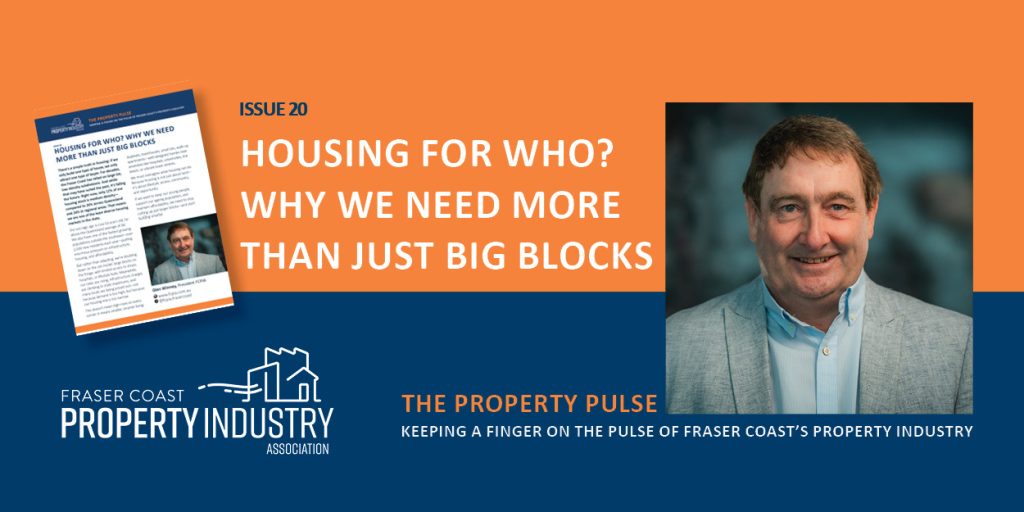
There’s a simple truth in housing: if we only build one type of house, we only attract one type of buyer. For decades, the Fraser Coast has relied on large-lot, low-density subdivisions. And while that may have suited the past, it’s failing the future. Right now, only 12% of our housing stock is medium density – compared to 26% across Queensland and 24% in regional areas. That means we are one of the least diverse housing markets in the state. Our average age is now 51 years old, far above the Queensland average of 38. We also have one of the fastest growing populations outside the southeast—over 2,500 new residents each year—putting enormous pressure on infrastructure, housing, and affordability. But rather than adapting, we’re doubling down on the old model: large blocks on the fringe, with limited access to shops, hospitals, or lifestyle hubs. Meanwhile, our rates are rising, infrastructure charges are climbing to state maximums, and many locals are being priced out – not because demand is too high, but because our housing mix is too narrow. This doesn’t mean high-rises on every corner. It means smaller, smarter living: duplexes, townhouses, small lots, walk-up apartments—well-designed homes near amenities like hospitals, universities, the beach, or vibrant town centres. We must reimagine what housing can be. Because housing is not just about land—it’s about lifestyle, access, community, and opportunity. If we want to keep our young people, support our ageing population, and maintain affordability, we need to stop cutting up just larger blocks—and start building smarter.
FCPIA – 15 July 2025 – MEDIA RELEASE
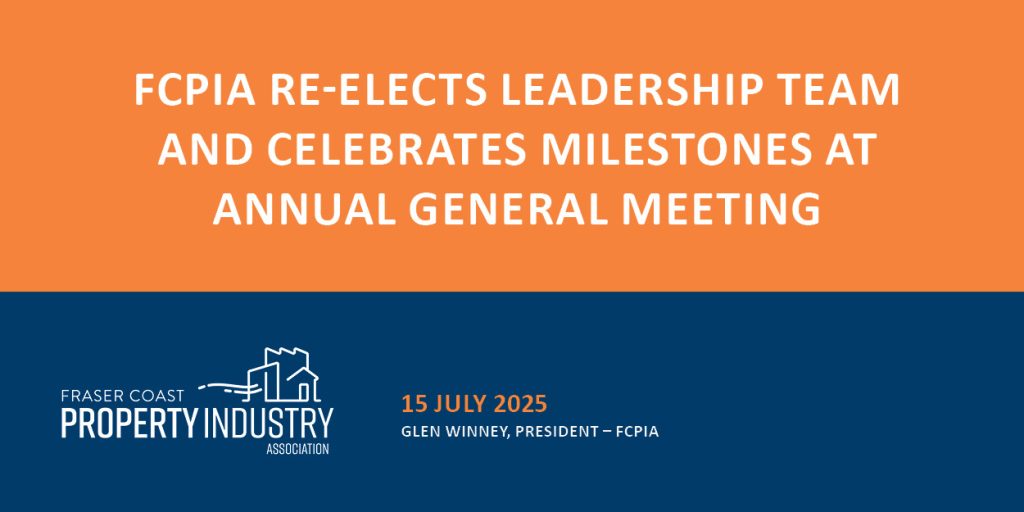
Fraser Coast Property Industry Association Re-Elects Leadership Team and CelebratesMilestones at Annual General Meeting. The Fraser Coast Property Industry Association (FCPIA) held its Annual General Meeting on 15July 2025 at the Fraser Room, Boat Club Hervey Bay. The meeting was attended by a strongrepresentation of members and featured the re-election of the entire Management Committee foranother term. We are pleased to confirm the re-election of Glen Winney as President, David Buckley as VicePresident, Peter Bennet as Treasurer, and Maggie Brennan as Secretary. Kim Carter and CameronSonter continue their roles on the Executive Committee, reflecting the team’s unity and consistentleadership. In addition to the Executive Committee, the FCPIA’s two subcommittees – Policy (Ward Vietch,Kane Macready, Jemma Derksen, Robert Mackay) and Events & Marketing (Ingrid Gorissen) – alsoremain unchanged. The Policy Subcommittee continues to tackle critical infrastructure andplanning issues, while the Events Committee continues to deliver standout professional andcommunity events. President Glen Winney highlighted the Association’s momentum over the past 12 months.Membership has grown to nearly 100 corporate members from a diverse mix of industries. TheAssociation delivered several successful workshops, including the popular Development Lifecyclesession, a Q&A with top accountants, and an energising session with guest speaker Allan Pease.The flagship “Women in Heels” event raised around $10,000 for Fraser Coast Mates and returnsthis August. FCPIA’s policy influence continues to grow through the strength of its Memorandum ofUnderstanding (MOU) with Council. The Association is actively contributing to policy on planningschemes, infrastructure charges, housing diversity, and more. Its 2025/26 Priority Projects listoutlines key regional initiatives the FCPIA is advocating for. Weekly opinion columns and active digital engagement have kept the community informed, andthe Association remains passionate about youth retention as a long-term economic andcommunity goal. Glen Winney commented, “It’s our growing and engaged membership that gives us influence withlocal, state and federal governments. I encourage every member to invite just one other businessto join – because the louder our collective voice, the stronger our region’s future.” For further information, please contact:Glen WinneyPresident, Fraser Coast Property Industry AssociationE: admin@fcpia.com.au
What If Our Retail Strips Were Our Greatest Showcase?
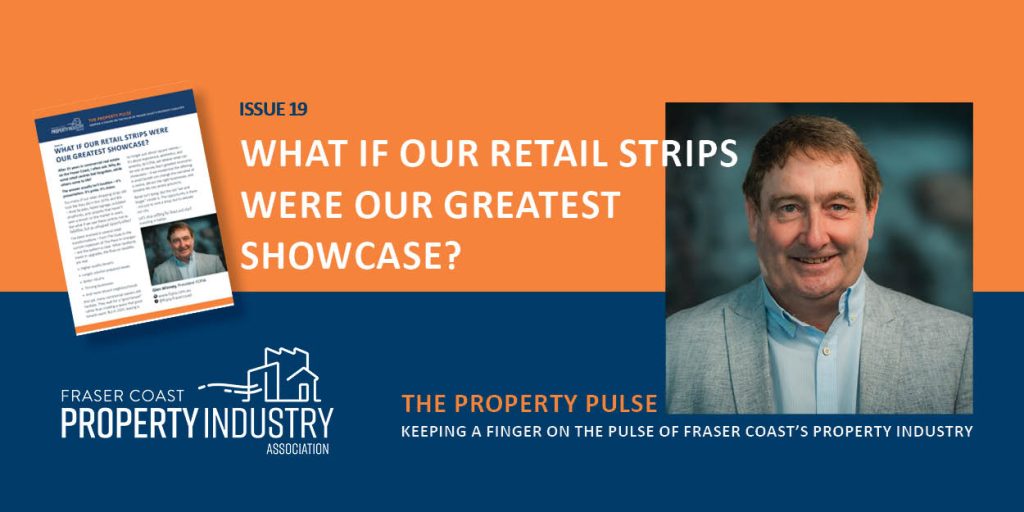
After 25 years in commercial real estate on the Fraser Coast, I often ask: Why do some retail centres feel forgotten, while others come to life? The answer usually isn’t location – it’s presentation. It’s pride. It’s vision. Too many of our older shopping strips still look like they did in the 1970s and 80s – tired facades, faded signage, outdated shopfronts, and carparks that haven’t seen a broom or line marker in years. But what if we saw these centres not as liabilities, but as untapped opportunities? I’ve been involved in several retail transformations – from The Quay to the current makeover of The Place in Urangan – and the pattern is clear. When landlords invest in upgrades, the flow-on benefits are real:– Higher quality tenants– Longer, solicitor-prepared leases– Better returns– Thriving businesses– And more vibrant neighbourhoods And yet, many commercial owners still hesitate. They wait for a “good tenant” rather than creating a space that good tenants want. But in 2025, leasing is no longer just about square metres – it’s about experience, aesthetics, and amenity. At FCPIA, we believe retail can be one of Hervey Bay’s greatest economic showcases – if we modernise the offering. A small facelift can change the narrative of a centre, attract the right businesses, and breathe life into entire precincts. Retail isn’t dying. But the old “set and forget” model is. The opportunity is there – not just to rent a shop, but to elevate our city. Let’s stop settling for tired and start investing in better.
Community Intelligence: The Power We Hold Together
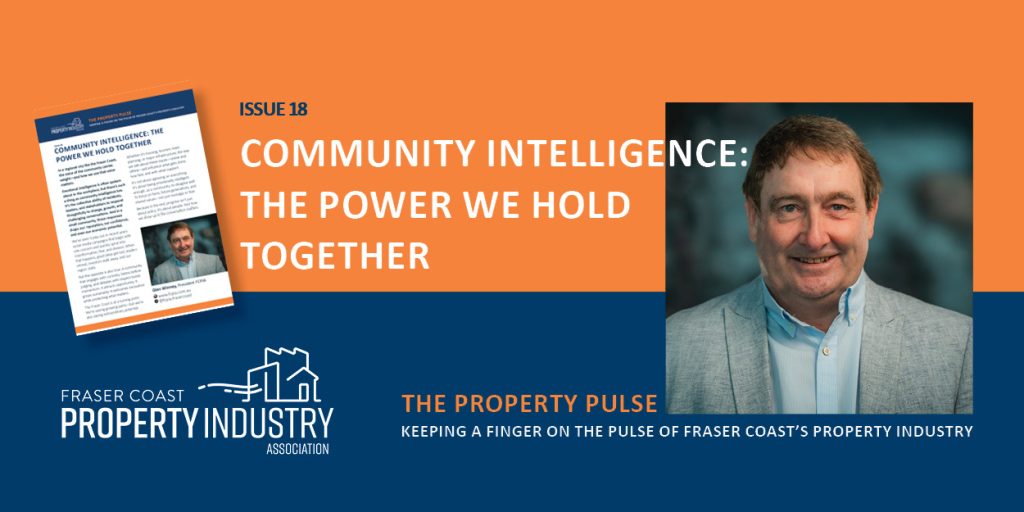
In a regional city like the Fraser Coast, the voice of the community carries weight—and how we use that voice matters. Emotional intelligence is often spoken about in the workplace, but there’s such a thing as community intelligence too. It’s the collective ability of residents, leaders, and stakeholders to respond thoughtfully to change, growth, and challenging conversations. And in a small community, those responses shape our reputation, our confidence, and even our economic potential. We’ve seen it play out in recent years: social media campaigns that begin with one concern and quickly spiral into misinformation, fear, and division. When that happens, good ideas get lost, leaders retreat, investors walk away, and our region stalls. But the opposite is also true. A community that engages with curiosity, listens before judging, and debates with respect builds momentum. It attracts opportunity. It grows sustainably. It welcomes innovation while protecting what matters. The Fraser Coast is at a turning point. We’re seeing growing pains—but we’re also seeing extraordinary potential. Whether it’s housing, tourism, town planning, or major infrastructure, the way we talk about these issues—online and offline—will influence what gets done, how fast, and with what support. It’s not about agreeing on everything. It’s about being emotionally intelligent enough, as a community, to disagree well. To focus on facts, future generations, and shared values—not just nostalgia or fear. Because in the end, progress isn’t just about policy. It’s about people. And how we show up in the conversation matters.
Flying High: Air Connectivity Fuels Fraser Coast’s Future
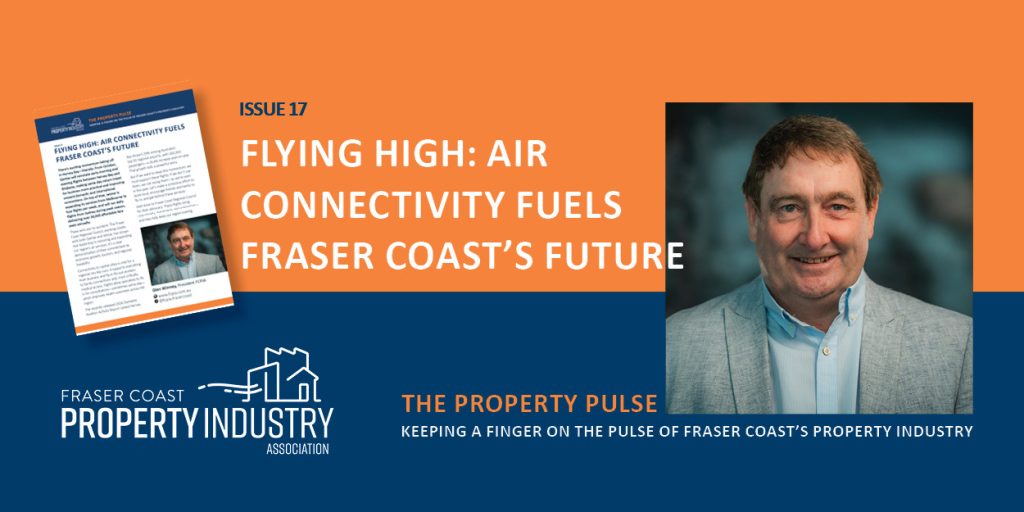
There’s exciting momentum taking off in Hervey Bay—literally. From October, Qantas will reinstate early morning and evening flights between Hervey Bay and Brisbane, making same-day return travel for business more practical and improving onward domestic and international connections. On top of that, Jetstar is expanding its services from Melbourne to four flights per week, and will run daily flights from Sydney during peak season, delivering over 38,000 affordable fare seats annually. These wins are no accident. The Fraser Coast Regional Council, working closely with both Qantas and Jetstar, has shown real leadership in restoring and expanding our region’s air services. It’s a clear demonstration of their commitment to economic growth, tourism, and regional liveability. Connectivity to capital cities is vital for a regional city like ours. It supports everything from business and fly-in-fly-out workers to family connections and, most critically, medical access. Flights allow specialists to fly in for consultations—sometimes same-day—which improves health outcomes across the region. The recently released 2024 Domestic Aviation Activity Report ranked Hervey Bay Airport 29th among Australia’s top 50 regional airports, with 183,300 passengers—a 24.6% increase year-on-year. That growth tells a powerful story. But if we want to keep this momentum, we must support these flights. If we don’t use them, we risk losing them—as we’ve seen in the past. Let’s make a conscious effort to book local, encourage friends and family to fly in, and get behind these services. Well done to Fraser Coast Regional Council for their advocacy. These flights bring opportunity, investment, and connection—and they help keep our region soaring.
Nostalgia Isn’t a Strategy
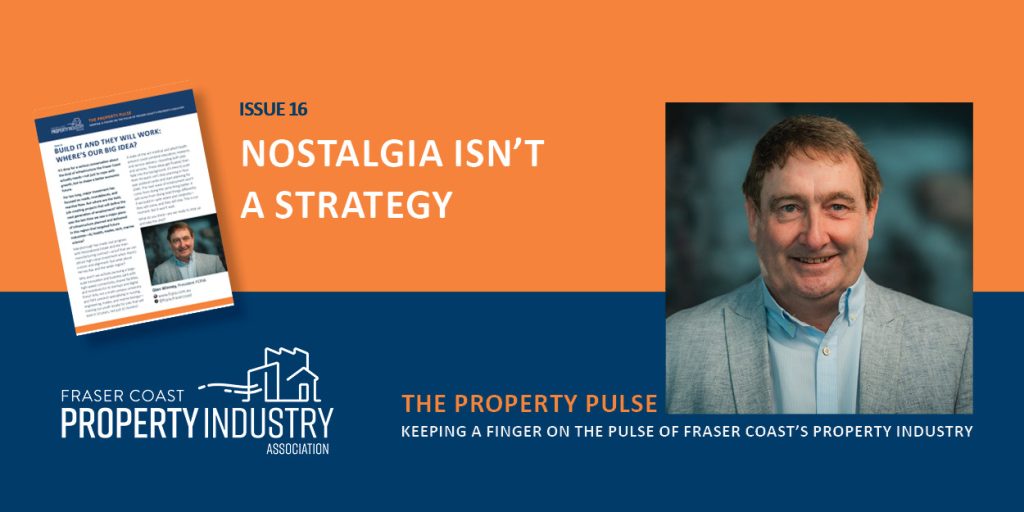
It’s comforting to look back. To remember “how we used to do things” and preserve the parts of Hervey Bay that made it special. But when it comes to shaping the future, nostalgia can’t be the strategy. The next generation doesn’t want to simply inherit the past—they want to shape what comes next. And right now, change is happening faster than ever. From four-day work weeks to remote offices, the very idea of how and where we work is shifting. AI is on track to become the greatest disrupter of our era, affecting everything from business models to transport, health care, education, and entertainment. The facilities we build now—whether for work, sport, learning, or leisure—need to reflect where we’re going, not just where we’ve been. It’s not enough to build “what we’ve always had.” We need to be designing cities and infrastructure that embrace technology, flexibility, and a more dynamic way of living. That means challenging the idea that preserving the past is always the best path. Yes, history matters—but progress requires courage. Courage to invest in innovation, plan for AI integration, rethink outdated zoning, and design environments that meet the expectations of tomorrow’s workers, students, and families. The Fraser Coast can be a leader in this shift—but only if we choose to evolve. The rest of the world is moving. Will we keep up, or keep looking backwards? Let’s build a future the next generation will be proud to call their own.
Build It and They Will Work Where’s Our Big Idea?
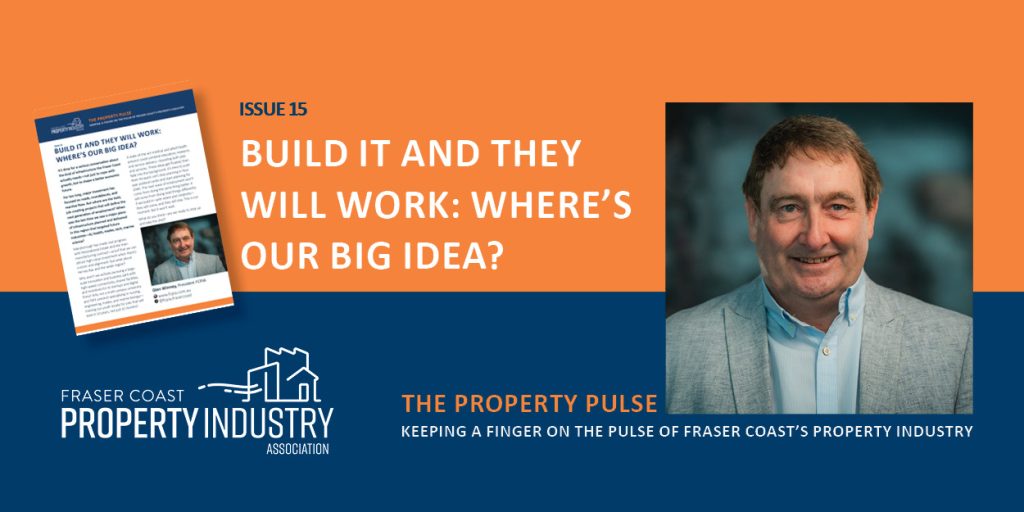
It’s time for a serious conversation about the kind of infrastructure the Fraser Coast actually needs—not just to cope with growth, but to shape a better economic future. For too long, major investment has focused on roads, roundabouts, and reactive fixes. But where are the bold, job-creating projects that will define the next generation of employment? When was the last time we saw a major piece of infrastructure planned and delivered in this region that targeted future industries—AI, health, trades, tech, marine science? Maryborough has made real progress with Moonaboola Estate and the train manufacturing contract—proof that we can attract high-value investment when there’s a vision and alignment. But what about Hervey Bay and the wider region? Why aren’t we actively pursuing a large-scale innovation and business park with high-speed connectivity, shared facilities, and incentives for AI startups and digital firms? Why not a multi-campus university and TAFE precinct specialising in nursing, engineering, trades, and marine biology—training our youth locally for jobs that will exist in 10 years, not just 10 months? A state-of-the-art medical and allied health precinct could combine education, research, and service delivery—boosting both jobs and services. These ideas get floated, then fade into the background. It’s time to push them forward. Let’s stop planning in four-year political cycles and start planning for 2040. The next wave of employment won’t come from doing the same thing better. It will come from doing bold things differently. If we build it—with intent and creativity—they will come, and they will stay.
Who is FCPIA—and Why It Matters
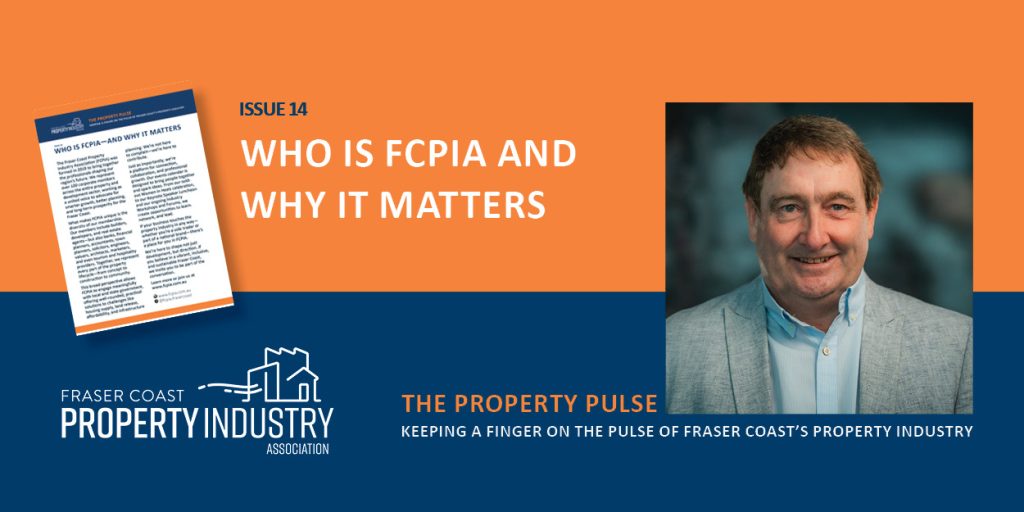
Who is FCPIA—and Why It Matters The Fraser Coast Property Industry Association (FCPIA) was formed in 2019 to bring together the professionals shaping our region’s future. We represent over 100 corporate members across the entire property and development sector, working as a united voice to advocate for smarter growth, better planning, and long-term prosperity for the Fraser Coast. What makes FCPIA unique is the diversity of our membership. Our members include builders, developers, and real estate agents—but also banks, financial planners, accountants, town planners, solicitors, engineers, valuers, architects, marketers, and even tourism and hospitality providers. Together, we represent every part of the property lifecycle—from concept to construction to community. This broad perspective allows FCPIA to engage meaningfully with local and state government, offering well-rounded, practical solutions to challenges like housing supply, land release, affordability, and infrastructure planning. We’re not here to complain—we’re here to contribute. Just as importantly, we’re a platform for connection, collaboration, and professional growth. Our events calendar is designed to bring people together and spark ideas. From our sold-out Women in Heels celebration, to our Keynote Speaker Luncheon and our ongoing Industry Workshops and Forums, we create opportunities to learn, network, and lead. If your business touches the property industry in any way—whether you’re a sole trader or part of a national brand—there’s a place for you in FCPIA. We’re here to shape not just development, but direction. If you believe in a vibrant, inclusive, and sustainable Fraser Coast, we invite you to be part of the conversation. 👉 Learn more or join us at https://fcpia.com.au/register/
Fraser Coast: A Snapshot of a Region in Transition
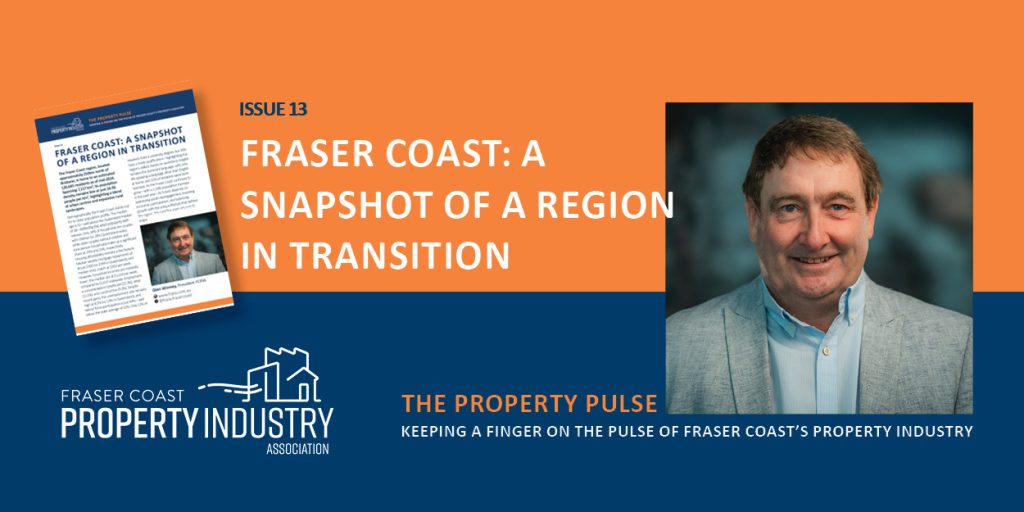
The Fraser Coast region, located approximately 250km north of Brisbane, is home to an estimated 120,685 residents as of mid-2024. Spanning 7,117 km², its population density remains low at just 16.96 people per km², highlighting a blend of urban centres and expansive rural landscapes. Demographically, the Fraser Coast stands out for its older population profile. The median age is 51—well above the Queensland median of 38—reflecting the area’s popularity with retirees. Only 19% of households are couples with children (vs 28% Queensland-wide), while older couples without children and lone-person households make up a significant share at 19% and 25%, respectively. Housing affordability remains a key feature. Median weekly mortgage repayments sit at just $300 (vs $399 in Queensland), and median rents match at $300 per week. However, household incomes are markedly lower: the median sits at $1,114 per week, compared to $1,637 statewide. Employment is concentrated in healthcare (21.3%), retail (11.1%), and construction (9.2%). Despite recent gains, the unemployment rate remains high at 8.5% (vs 5.4% in Queensland), and labour force participation is just 44%—well below the state average of 62%. Only 11% of residents hold a university degree, but 26% have a trade qualification—highlighting the region’s skilled, hands-on workforce. English remains the dominant language, with only 4% speaking a language other than English at home, and 15% of residents were born overseas. As the Fraser Coast continues to grow—with a 2.33% population increase in the past year—its future depends on addressing youth disengagement, boosting economic participation, and balancing growth with the unique lifestyle that defines the region.
Hervey Bay: Growth, Opportunity, and the Road Ahead
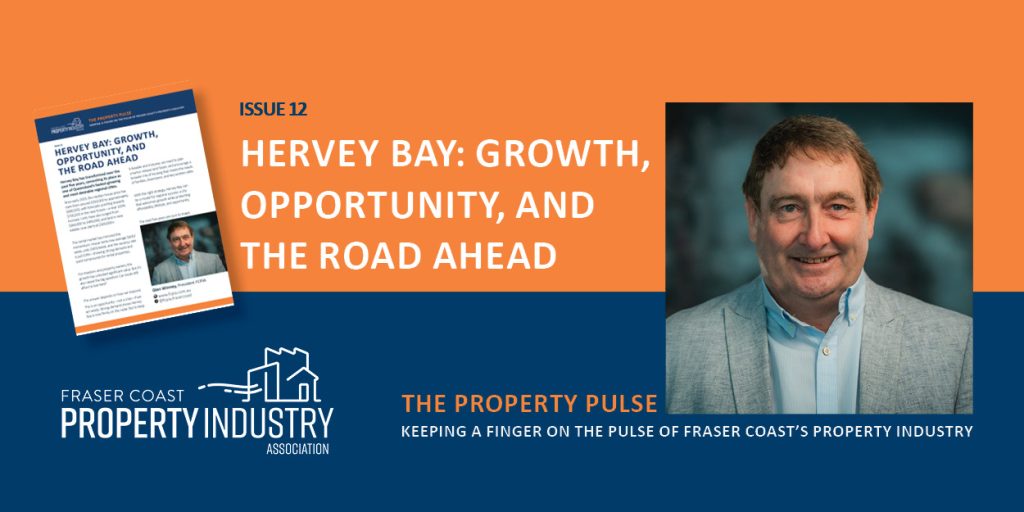
Hervey Bay has transformed over the past five years, cementing its place as one of Queensland’s fastest-growing and most desirable regional cities. Since early 2020, the median house price has risen from around $350,000 to approximately $680,000, with forecasts pointing towards $700,000 in the near future—a near 100% increase. Units have also surged from $264,000 to $490,000, and land in new estates now starts at $300,000+. The rental market has mirrored this momentum. House rents now average $600/week, units $465/week, and the vacancy rate is just 0.9%—showing strong demand and quick turnarounds for rental properties. For investors and property owners, this growth has unlocked significant value. But it’s also raised the big question: Can locals still afford to live here? The answer depends on how we respond. This is an opportunity—not a crisis—if we act wisely. Strong demand shows Hervey Bay is now firmly on the radar. But to keep it liveable and inclusive, we need to plan smarter, release land faster, and encourage a broader mix of housing that meets the needs of families, downsizers, and key workers alike. With the right strategy, Hervey Bay can be a model for regional success: a city that welcomes growth while protecting affordability, lifestyle, and opportunity. The next five years are ours to shape.
The Fraser Coast in Numbers: What Happens If We Stay on This Path?
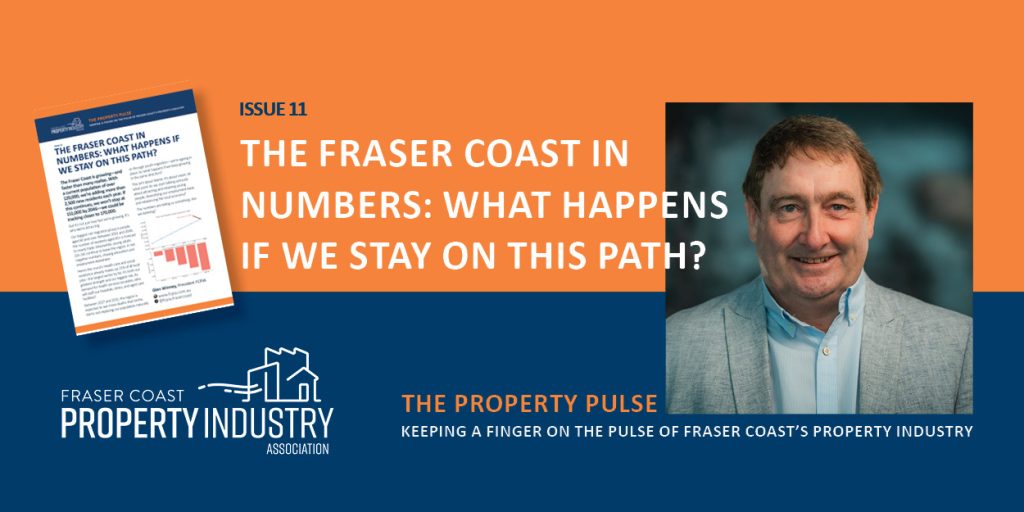
The Fraser Coast is growing—and faster than many realise. With a current population of over 120,000, we’re adding more than 2,500 new residents each year. If this continues, we won’t stop at 151,000 by 2046—we could be tracking closer to 170,000. But it’s not just how fast we’re growing. It’s who we’re attracting. Our biggest net migration group is people aged 60 and over. Between 2021 and 2046, the number of residents aged 85+ is forecast to nearly triple. Meanwhile, young adults (18–24) continue to leave the region, in net negative numbers, chasing education and employment elsewhere. Here’s the crunch: Health care and social assistance already makes up 21% of all local jobs—the largest sector by far. It’s both our greatest strength and our biggest risk. As demand for health services escalates, who will staff our hospitals, clinics, and aged care facilities? Between 2027 and 2031, the region is expected to see more deaths than births. We’re not replacing our population naturally or through youth migration—we’re ageing in place. So what happens if we keep growing in the same direction? This isn’t about blame. It’s about vision. At what point do we start talking seriously about attracting and retaining young people, diversifying our employment base, and rebalancing the local economy? The numbers are telling us something. Are we listening?
The Media’s Role in Shaping Our City’s Future

In regional cities like ours, the media often holds more influence than it does in capital cities. Its role in shaping public perception around progress, development, and leadership cannot be understated. A single headline, social media post or comment can either support much-needed change—or stall it. At its best, media provides balanced reporting, genuine investigative journalism, and gives voice to diverse perspectives. At its worst, it pushes personal opinions, fuels divisive Facebook debates, and amplifies misinformation. When media drives an agenda instead of reporting facts, it undermines genuine community debate and damages trust in the process. The future of our city depends on leadership—both elected and within the community. But progress is fragile. Leaders who step forward to improve our region are too often met with criticism driven by the tall poppy syndrome and a lingering small-town mindset. Some local outlets are too quick to tear down rather than build up. It’s time for a cultural shift. Our media must embrace its responsibility to inform—not inflame. The way we report and respond to local issues can either pave the way for a vibrant, prosperous city, or drag it backward. FCPIA believes our region deserves constructive journalism, honest discussion, open debate and a shared focus on building a better future—for all of us, and for the next generation.
Fear, Greed & the Fraser Coast Market: Why the Long Game Wins

If you want to understand any property market, strip it right back to the basics: fear and greed. These two emotions drive every boom and bust, and nowhere has this been clearer than on the Fraser Coast since COVID. In early 2020, fear gripped the world. Our local property market ground to a halt overnight. Buyers walked away from contracts, confidence evaporated, and panic set in. But six months later, something changed. A wave of Australians began rethinking their lifestyles. The shine came off the big cities, long commutes, and crowded office towers. Regional living became the dream — and Hervey Bay was right in the crosshairs. Migration surged, with over 2,500 new residents arriving each year. Demand for housing skyrocketed — we needed 1,200 new dwellings annually just to keep up. Then came the greed. FOMO (Fear of Missing Out) kicked in. Prices soared, rentals exploded, and we saw five straight years of growth. Now in early 2025, there’s a wobble. Global politics, inflation fears, and market jitters are slowing activity — but not prices. Because while fear may cause hesitation, the greed for lifestyle, space, and freedom is still alive and well. The lesson? Don’t get caught up in short-term panic or hype. Real estate rewards the patient. Play the long game, because no matter how many dips you hit along the way, property always trends upward over time. Fear and greed will always be part of the story — just don’t let them write yours.
FCPIA’s Position on Torquay Foreshore
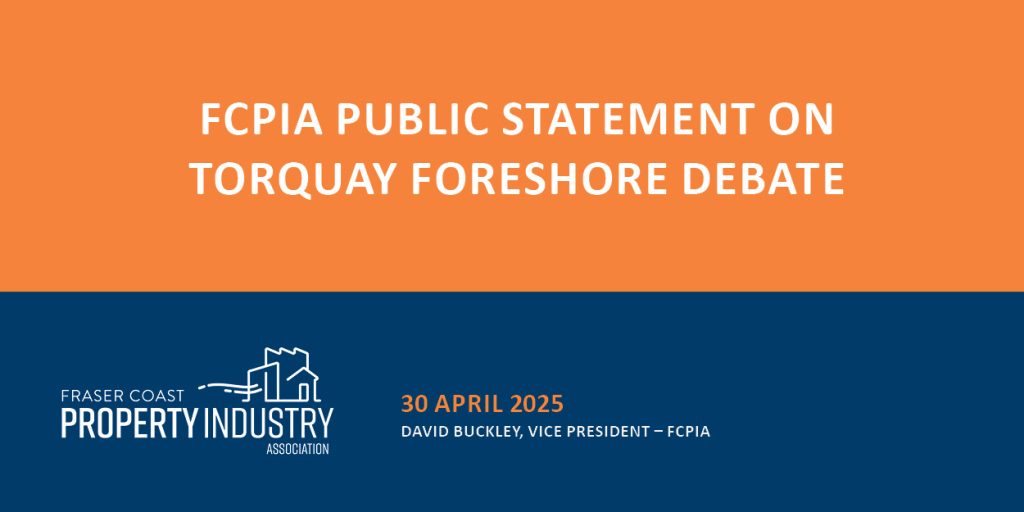
Following the various articles in The Hervey Bay Advertiser and written by its Editor, the Fraser Coast Property Industry Association (FCPIA) wishes to record its position on the future of the Torquay foreshore and the land taken up by the Torquay Caravan Park. For the development industry the Esplanade foreshore is the jewel in the crown that attracts people and investment to Hervey Bay – the lifeblood of our industry. The FCPIA has advocated for the enhancement of the Esplanade foreshore as recreational space for the benefit of locals of all generations and tourists, with reduced vehicle traffic and made more friendly for pedestrians, bikes and scooters. We support the Master Plan for the Esplanade Foreshore recently adopted by the Fraser Coast Regional Council, which in our view should be more ambitious. When a resolution to spend some $22 million on redevelopment of Council caravan parks came to the Councillors, the FCPIA was concerned that this would lock away prime spaces of the Esplanade from use by the whole community for another generation without considering their alternate use as recreational hubs – a more inclusive option that allows everyone, not just caravanners to enjoy those parts of the foreshore – and the economic benefits of that enhancement. The FCPIA provided a letter of support for a Council motion to temporarily pause the redevelopment to allow for further review, which was passed by a majority of Councillors and then a letter of support for the subsequent motion (also passed by a majority of Councillors) to develop concept plans for the Torquay Caravan Park as open space with basic facilities or a premium playground and recreational hub and then seek community feedback on its future. Until those plans are available any public debate is necessarily limited and, in our view premature.The FCPIA is of the view that it is misleading to characterise this issue as a decision to close the Torquay Caravan Park. This is about competing visions for the use of this part of the Torquay foreshore that requires consultation with the whole community when both options are on the table. And the FCPIA would be open to that consultation evolving alternative proposals. This is a passionate and divisive issue with great costs and benefits for both scenarios which is why we strongly support a structured, respectful, and informed community conversation. The FCPIA will consult its members and express the development industry views during the public consultation process and we encourage all stakeholders to engage constructively at that time. David Buckley, Vice President Fraser Coast Property Industry Association
From Fishing Village to Thriving Coastal City

Fifty years ago, Hervey Bay was little more than a sleepy seaside retreat with a population of just 10,737. Fast forward to 2025, and it’s a bustling regional city home to an estimated 68,000 people [1]—nearly a seven-fold increase. With the broader Fraser Coast Region sitting around 119,302 [1], Hervey Bay now carries the weight and promise of a true coastal hub. So what sparked this transformation? The 1980s were pivotal. In 1984, Hervey Bay was officially declared a city—just seven years after becoming a town. This status shift wasn’t just a title; it marked a new era of urban planning and investment. By 1991, the population had jumped to over 30,000, and by 2001, it reached 40,862. The city’s appeal to retirees seeking a relaxed, affordable lifestyle with ocean views turned it into one of Australia’s retirement hot spots. Tourism played an equally powerful role. Hervey Bay’s calm waters and proximity to World Heritage-listed K’gari (Fraser Island) made it an eco-tourism favourite—especially for whale watching. With nature on its doorstep, Hervey Bay quietly built an economy on leisure, hospitality, and health services. Today, Hervey Bay’s demographic is diversifying. More families and professionals are calling the region home, driving demand for schools, housing, and modern infrastructure. With the Fraser Coast expected to top 151,070 by 2046 [1], the challenge now is to grow smart—preserving lifestyle and nature while meeting the needs of a thriving population. From fishing shacks to bustling esplanades, Hervey Bay’s story is only just getting started.
Are We Planning for a Wide Bay That No Longer Exists?
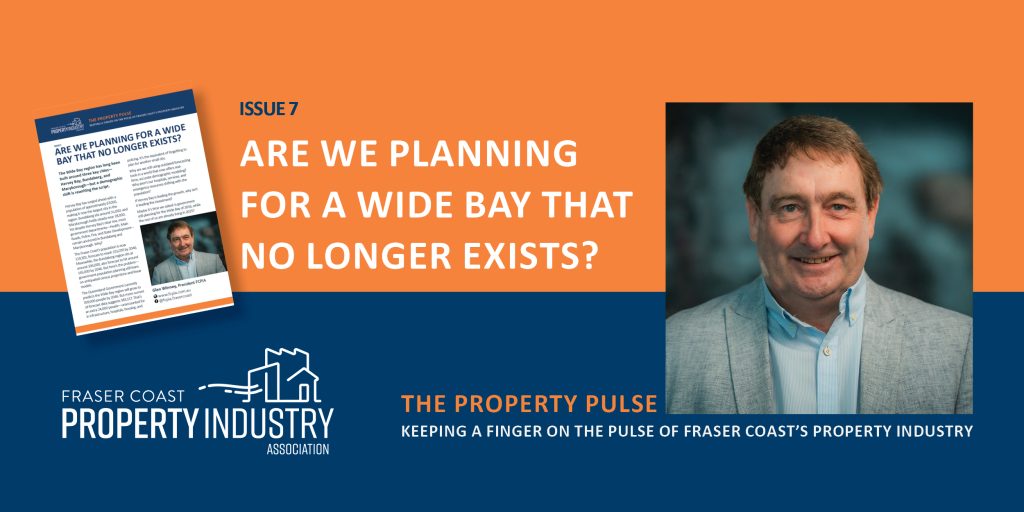
The Wide Bay region has long been built around three key cities—Hervey Bay, Bundaberg, and Maryborough—but a demographic shift is rewriting the script. Hervey Bay has surged ahead with a population of approximately 67,000, making it now the largest city in the region. Bundaberg sits around 55,000, and Maryborough holds steady near 28,000. Yet despite Hervey Bay’s clear rise, most government departments—Health, Main Roads, Police, Fire, and State Development—remain anchored in Bundaberg and Maryborough. Why? The Fraser Coast’s population is now 119,302, forecast to reach 151,070 by 2046. Meanwhile, the Bundaberg region sits at around 106,000, also forecast to hit around 145,000 by 2046. But here’s the problem—government population planning still leans on antiquated census projections and linear models. The Queensland Government currently predicts the Wide Bay region will grow to 359,000 people by 2046. But more current .id forecast data suggests 383,117. That’s an extra 24,000 people—unaccounted for in infrastructure, hospitals, housing, and policing. It’s the equivalent of forgetting to plan for another small city. Why are we still using outdated forecasting tools in a world that now offers real-time, accurate demographic modelling? Why aren’t our hospitals, services, and emergency resources shifting with the population? If Hervey Bay is leading the growth, why isn’t it leading the investment? Maybe it’s time we asked: Is government still planning for the Wide Bay of 2016, while the rest of us are already living in 2025?
Where is Hervey Bay, Really?

Hervey Bay is now the biggest city in the Wide Bay region and one of the fastest growing in Queensland—so why don’t we actually have a suburb called Hervey Bay? It’s an odd quirk when you think about it. Our city’s name lives in the minds of millions—known for whales, beaches, and K’gari ( Fraser Island) —but not in the maps, real estate listings, or weather updates. Our CBD? That’s Pialba. Search Hervey Bay in Google Maps or realestate.com.au, and you get a dotted patchwork of suburb names few outsiders recognise. There’s no land-based place officially called “Hervey Bay” at all. Just water. Compare this to Bundaberg, Maryborough, Brisbane—each has a central suburb bearing the city’s name. It gives clarity, a sense of identity, and online visibility. But for us, it’s different. Even the Bureau of Meteorology struggles to pin us down. Some news outlets skip over us entirely on the nightly weather. And that’s not just a technicality—it’s a missed marketing opportunity, a blind spot in our digital footprint. With the council chambers soon moving into the CBD, we have a rare window to reshape how Hervey Bay is seen, not just locally, but nationally. What if we renamed the core area “Hervey Bay CBD”? What would that mean for our future identity, for tourism, for investment, for civic pride? Is it time we stopped being just a collection of suburbs and started being seen—and mapped—as a real city? It’s a conversation worth having.
Why Is Development Still a Dirty Word in 2025?

Despite decades of evolution, regulation, and professionalism, the term “development” still makes many Australians uneasy. It lingers as a trigger word—conjuring images of greed, bulldozers, and soulless suburbs. But why? And more importantly, is that perception still valid in 2025? Much of the mistrust traces back to the Gold Coast’s notorious “white shoe brigade” of the 1980s—a colourful era marked by questionable ethics, unchecked sprawl, and political influence. But that was over 40 years ago. Today’s development landscape is nothing like that. In fact, the property and infrastructure development sector in Australia is now dominated by some of the most tightly regulated, transparent, and professionally run organisations in the country.According to the Property Council of Australia: So why, in 2025, is the word “developer” still met with scepticism, while companies like Woolworths or NAB—which also turn massive profits—are simply accepted parts of everyday life? We rarely pause to consider that nearly everything that shapes our lifestyle—the homes we live in, the cafes we brunch in, the schools our kids attend, the medical centres we rely on, the shopping centres we visit—was built by a developer. Even the parks, footpaths, and sporting facilities in new communities are often delivered by developers as part of planning conditions and infrastructure agreements. Development is not just about profit—it’s about placemaking. It’s about envisioning how people live, move, work, and connect with their environment. And yet, when a development company delivers a successful project and stays afloat financially, it’s often criticised for “profiting from the community.” This begs a deeper question:What is it in the Australian psyche that resents the very industry responsible for building our modern lifestyle?Is it tall poppy syndrome? Is it a lack of trust in the planning process? Is it media-fuelled opposition politics? Or is it that people simply don’t see the connection between development and the everyday fabric of their lives? At FCPIA, we believe it’s time to challenge the outdated narrative and ask ourselves:Are we as a society ready to have an honest, mature conversation about the role of development in shaping Australia’s future? Or are we still clinging to myths that no longer reflect reality?
Is Sports Tourism the Next Phase of Fraser Coast’s Growth and Youth Retention?

The recent announcement that Olympic archery will be hosted right here on the Fraser Coast is a game-changer—not just for Maryborough, but for our entire region. This isn’t just about sport. It’s about putting Fraser Coast on the global stage and seizing a once-in-a-lifetime opportunity to shape our future. Imagine what we could achieve with a clear, coordinated sports tourism strategy—one that taps into the buzz of the 2032 Games and positions us as Queensland’s regional sporting capital. We have all the raw ingredients: a flat, scenic Esplanade perfect for triathlons, cycling, and fun runs; calm waters ideal for sailing, swimming, and fishing; and Maryborough’s equestrian grounds and natural bushland for everything from cross-country to adventure sports. Our underdeveloped—but full-of-potential—sports precinct could host basketball, netball, all codes of football, and more… if we get serious about investment and planning now. The economic ripple effect could be enormous—accommodation, hospitality, retail, transport—every sector wins. But even more importantly, we give our young people something to be part of. Something to train for. To stay for. To be proud of. But we can’t sit back and hope it all just happens. We need a strategic, region-wide push—complete with an annual sports tourism calendar, targeted events, and funding advocacy. Let’s rally local clubs, tourism operators, schools, and councils to act—together. This is our moment. But it won’t wait.What do you think—are we ready to step up and take the shot?
Bridging Generations: Unleashing Potential Through Mentorship on the Fraser Coast

The Fraser Coast boasts one of Australia’s most seasoned demographics, with an average age of 51. While some may view this through a lens of challenge, if we play our cards right, it’s a goldmine of opportunity. Imagine leveraging this collective repository of global business savvy and hard-earned wisdom—what a powerhouse we could become! Why not channel this potential into dynamic mentorship programs? Picture this: seasoned professionals and sharp retirees guiding our ambitious young entrepreneurs. Such collaborations could transform the business landscape of the Fraser Coast, turning it into a beacon of innovation and growth. Specifically, our property sector is crying out for fresh faces. From consultants to tradespeople to sales experts, there’s a noticeable shortage of young talent. And let’s be honest, the traditional “lecture” approach—whether in classrooms or boardrooms—isn’t cutting it. Today’s youth are nurtured in a culture of rapid-fire Facebook critiques and Tweets, where every opinion is instant and every rebuttal is just a click away. They don’t need more lectures; they need mentors who can guide them through the real-world maze of professional growth and success. What if we stop merely talking at our youth and start actively investing in them? Let’s create mentoring opportunities that not only transfer knowledge but also ignite curiosity and foster long-term relationships. It’s time for the Fraser Coast to embrace its potential as a mentoring hub, bridging the gap between experienced wisdom and youthful innovation. Can we inspire a shift from passive observation to active engagement? Here’s to hoping we can spark not just interest but action, shaping a vibrant future for both our valued elders and the promising next generation.
Shaping a Thriving Fraser Coast: The Future of Affordable Housing
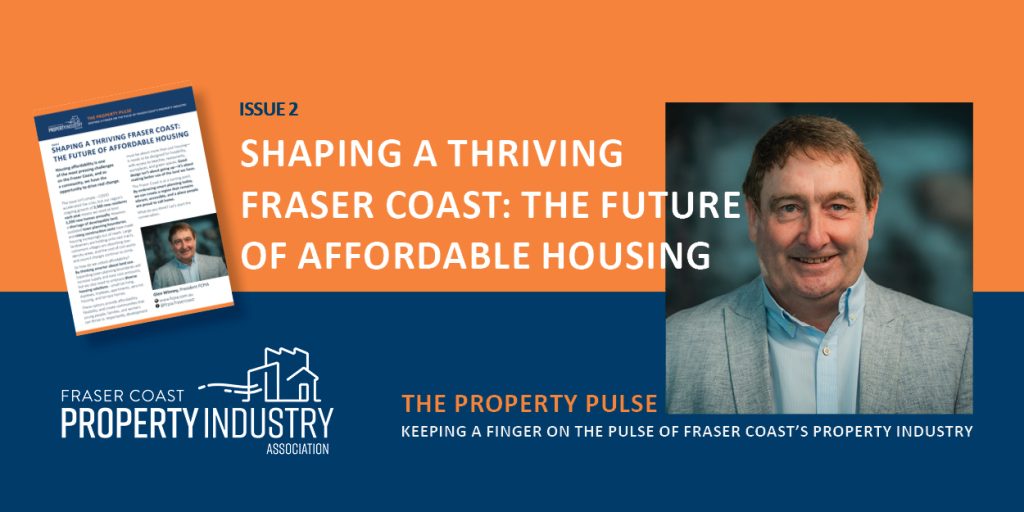
Housing affordability is one of the most pressing challenges on the Fraser Coast, and as a community, we have the opportunity to drive real change. The issue isn’t simple—COVID accelerated the crisis, but our region’s ongoing growth of 2,500 new residents each year means we need at least 1,200 new homes annually. However, a shortage of developable land, outdated town planning boundaries, and rising construction costs have made housing increasingly out of reach. Large landowners are holding onto vast tracts, retirement villages are absorbing low-density areas, and the cost of civil works and council charges continue to climb. So how do we unlock affordability? By thinking smarter about land use. Expanding town planning boundaries will increase supply and ease cost pressures, but we also need to embrace diverse housing solutions—small lot living, duplexes, triplexes, apartments, zero-lot housing, and terrace homes. These options provide affordability, flexibility, and create communities that young people, families, and workers can thrive in. Importantly, development must be about more than just housing—it needs to be designed for liveability, with access to beaches, restaurants, workplaces, and green spaces. Good design isn’t about going up—it’s about making better use of the land we have. The Fraser Coast is at a turning point. By embracing smart planning today, we can create a region that remains vibrant, accessible, and a place people are proud to call home. What do you think? Let’s start the conversation.
Does the Fraser Coast Lack Vision?
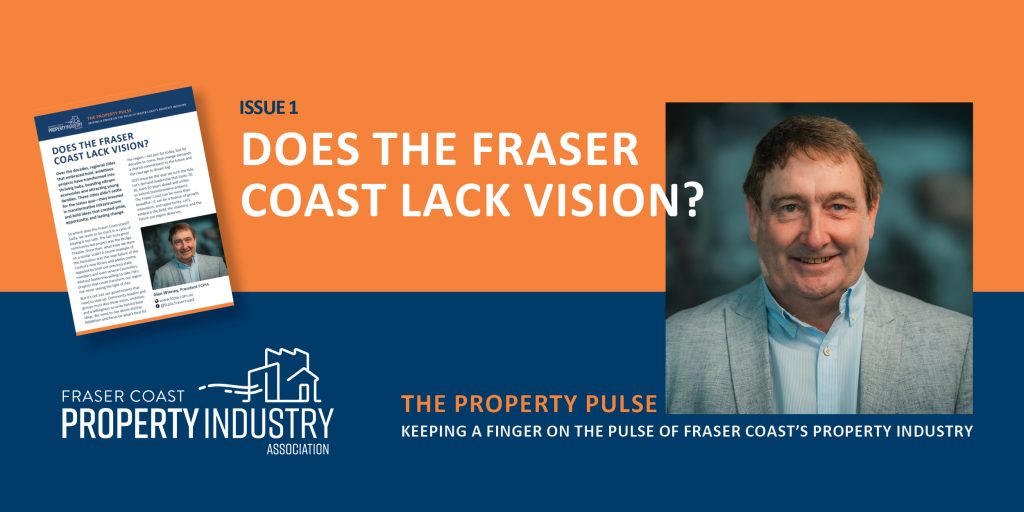
Over the decades, regional cities that embraced bold, ambitious projects have transformed into thriving hubs, boasting vibrant economies and attracting young families. These cities didn’t settle for the status quo—they invested in transformative infrastructure and bold ideas that created pride, opportunity, and lasting change. So where does the Fraser Coast stand? Sadly, we seem to be stuck in a cycle of playing it too safe. The last truly great community-led project was the Brolga Theatre. Since then, what have we done on a similar scale? A recent example of this hesitation was the near failure of the Council’s new library and admin centre, opposed by both our previous state members and even several Councillors. Without leadership willing to take risks, projects that could transform our region risk never seeing the light of day. But it’s not just our governments that need to step up. Community leaders and groups must also show vision, ambition, and a willingness to unite behind bold ideas. We need to rise above divisive NIMBYism and focus on what’s best for the region—not just for today, but for decades to come. Real change demands a shared commitment to the future and the courage to dream big. 2025 must be the year we turn the tide. Let’s demand leadership that looks 20, 30, even 50 years ahead and unites us behind transformative projects. The Fraser Coast can be more than beautiful—it can be a beacon of growth, innovation, and opportunity. Let’s embrace the bold, the visionary, and the future our region deserves.
Reimagining Hervey Bay: Infrastructure and innovation for a changing world
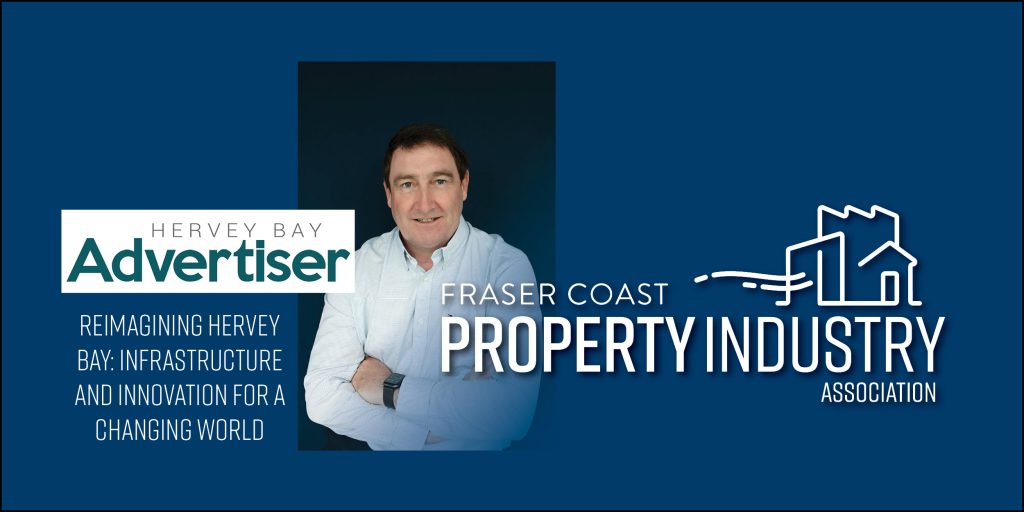
AS HERVEY Bay’s population ages, we stand at a pivotal economic crossroads. The world is changing rapidly, and we must change with it. Our infrastructure, education system, and urban landscape need a radical overhaul to attract a younger, more dynamic demographic and ensure our community thrives in the coming decades. Our education system must be redefined to cater to future jobs. Imagine a combined multi-university and TAFE campus right in the CBD. This hub of innovation and learning would not only provide cutting-edge education but also revitalize our accommodation and nightlife economy, turning Hervey Bay into a bustling, vibrant city that attracts and retains young talent. Our Esplanade, the jewel in Hervey Bay’s crown, also needs a transformation. It’s our main tourist attraction, but it must offer more to a wider range of age groups. Picture an Esplanade with a mix of family-friendly activities, adventure sports, and chic cafes and restaurants. This would not only draw more tourists but also make Hervey Bay a more exciting place to live. Infrastructure is the backbone of this vision. We need better transportation networks, modern healthcare facilities, and robust digital infrastructure to support new businesses and remote workers. But it’s not just about building more; it’s about building smart. We must create spaces that encourage community interaction, innovation, and economic growth. The time for bold ideas and decisive action is now. Hervey Bay must evolve to meet the demands of a changing world. This is our chance to create a vibrant, inclusive, and prosperous future for all. Are we ready to seize it? Published in the Hervey Bay Advertiser Interested in the Fraser Coast Property Industry? Join FCPIA Today | Click here to join Tagged 2024 Priorities, FCPIA, Hervey Bay advertiser, Hervey Bays Future, Youth,
Attracting youth to secure Hervey Bay’s future

| 25 July 2024 Attracting youth to secure Hervey Bay’s future HERVEY Bay faces a critical juncture: if we don’t pivot our focus towards attracting younger generations, we risk severe workforce shortages within the next 20 years. Our current trajectory, heavily skewed towards catering to retirees, is unsustainable. As president of the Fraser Coast Property Industry Association, I see firsthand the urgency of this issue. Post-COVID, our city’s demographics have shifted dramatically. Our average age has increased from 48 to 51, and a large segment of our workforce is on the brink of retirement. This impending “retirement cliff” threatens to deplete our labor force, stalling economic growth and innovation. We must act now to reverse this trend. Key to this reversal is investing in infrastructure that appeals to a younger demographic. This includes enhancing our nightlife economy, aligning education with job opportunities, and developing modern, affordable housing. Such infrastructure not only attracts young professionals but also retains our youth, preventing the brain drain that has plagued us for years. Furthermore, we need to reimagine our city’s image. Moving away from being perceived solely as a retiree haven, we must market Hervey Bay as a vibrant, dynamic community with diverse opportunities for all ages. This paradigm shift requires political will and community support, but the rewards are manifold: a balanced, thriving population and a robust, sustainable economy. By embracing these changes, we pave the way for a prosperous future for Hervey Bay. Let’s build a city that not only supports our current residents but also attracts and nurtures the talent of tomorrow. The time to act is now. Published in the Hervey Bay Advertiser Interested in the Fraser Coast Property Industry? Join FCPIA Today | Click here to join
ABC Wide Bay Radio | 10 July 2024
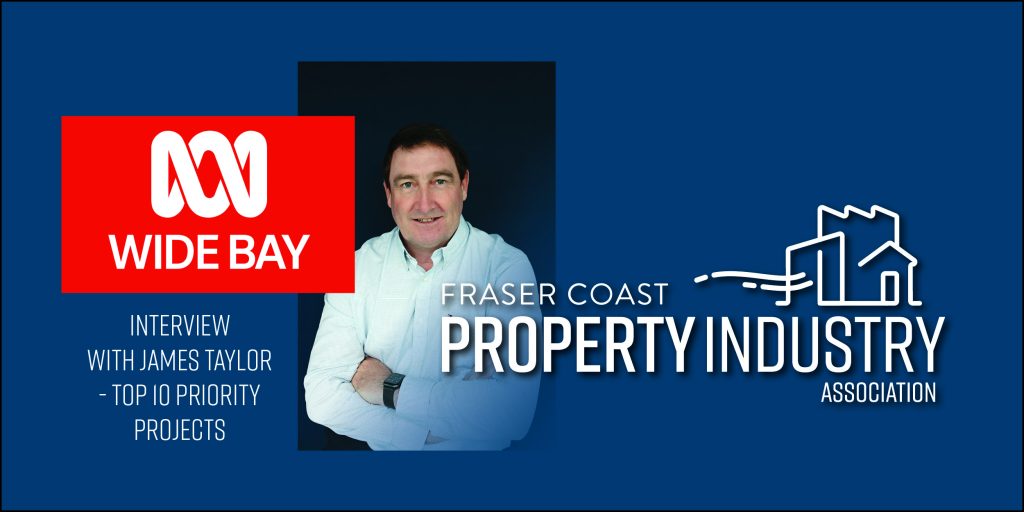
FCPIA President Glen Winney Discusses the FCPIA’s Top 10 Priority Projects on ABC Wide Bay with James Taylor Listen to the Interview HERE The Fraser Coast Property Industry Association (FCPIA) is making waves with the recent unveiling of its Top 10 Priority Projects Document. FCPIA President Glen Winney, in an engaging interview on ABC Wide Bay radio, spotlighted these critical initiatives, urging local council and government to prioritize them as the region heads into an election year. With the Fraser Coast’s growth outpacing previous projections, Winney emphasized the urgency of addressing these key projects to ensure sustainable and balanced development. He underscored the FCPIA’s role in steering this momentum, highlighting the association’s proactive approach in shaping the region’s future. 2024 Priority Projects HERVEY BAY’S BRUCE HIGHWAY CONNECTORFRASER COAST GATEWAYPlanning for a direct connector from the Bruce Highway to Hervey BayIdentify land and locationFund feasibility studyEmbed in Wide Bay Regional Plan & Main Roads Fraser Coast Integrated Transport Strategy HERVEY BAY ESPLANADESignificantly reduce vehicle traffic on the EsplanadeMore Pedestrian, Bicycle and Scooter FriendlyEnhanced Recreation Hub / Night Life EconomyRemove Torquay forshore caravan park for community recreational spaceFunding to deliver master plan, including Esplanade footpath widening, cycle lanes and underground works FRASER COAST SPORTS AND RECREATION PRECINCTFunding to undertake detailed design and construction of a multi function indoor sports facilityAddress shortfalls in Indoor and Outdoor sports facilities10,000 Seat Stadium HERVEY BAY / MARYBOROUGH WATER GRIDProtecting our water supply by linking the Burrum River and Mary River Catchments – $60 Million (Stage 1)Improve resilience and drought proofing our communitySecuring water beyond 2050 MARYBOROUGH HERVEY BAY ROAD – Chapel Road IntersectionPlan and upgrade the intersectionAllow for another school in the areaCater for growth South of the ridge line/NikenbahProvide missing Connection – Maryborough Rail Trail YOUTH RETENTIONJob opportunitiesNight life economyChange Housing Model (Right Sizing)Education that suits jobs HERVEY BAY MEDICAL PRECINCTSet Up a Fraser Coast Health BoardSet Up a Cardio Ward and Other Age appropriate ServicesFuture Infrastructure for Post-COVID Growth and AgingCreate masterplans including TAFE area HERVEY BAY MARINA AREAComplete master plan and fund outcomesStreamline the multiple leasesCreate freehold opportunities for DevelopmentExpand to Harbour to Cater for GrowthIncrease tourism facilities & Maritime Services Hub HERVEY BAY CBDCreate an Education PrecinctRename it ‘Hervey Bay’ as a SuburbBring in State Government Departments (Regional Head Offices)Bring TAFE into CBD to Reignite Youth RetentionCreate a night life Economy and Food Precinct WIDE BAY REGIONAL PLANNeeds a complete reviewGrowth Figures need to be updatedInclude Schools, Road upgrades & Health in Hervey bayFraser Coast will be the main growth centre of Wide BayNeed to identify current and future infrastructure needs See more on ABC Radio HERE
Rethinking Community Glue: Investing in Sports for a United Fraser Coast
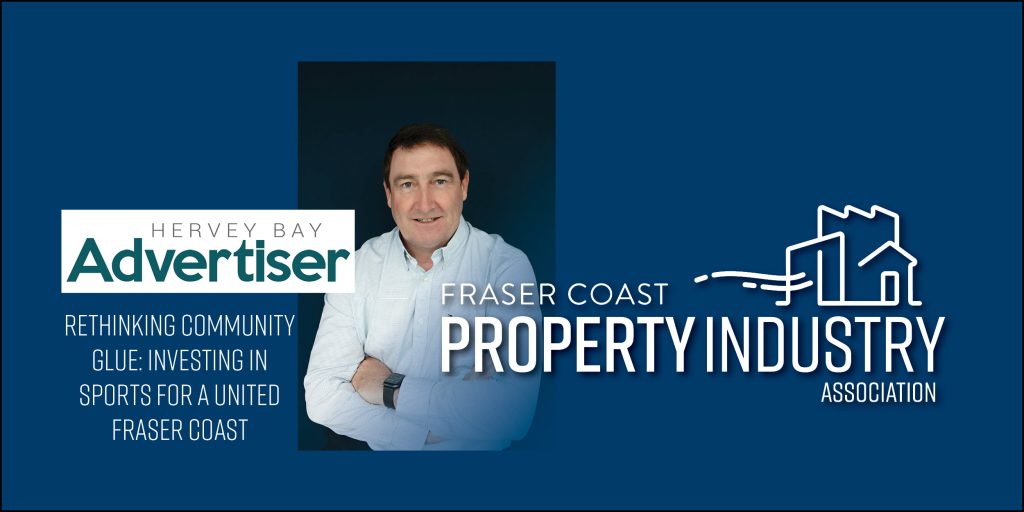
AUSTRALIA is changing, and as a region, we need to change with it, finding new ways to create our social glue. Insightful demographer Simon Kuestenmacher recently highlighted a profound shift: religion no longer serves as the primary social glue in our communities. Research shows that only 47.8% of the Fraser Coast identifies as Christian, while 41.3% have no religious affiliation at all. This raises a critical question: how do we pull our community together? The answer lies in a common denominator that now binds Australians: sport. From the Matildas’ inspiring performances to the fervour of the State of Origin. Sports have a unique ability to unite us. Therefore, if we are to invest in infrastructure, sports facilities and events should be at the forefront. Sports not only serve as the fabric of Australian communities but also play a crucial role in keeping our youth engaged, improving health and fitness, and fostering a sense of belonging. Unfortunately, our sports infrastructure has been underfunded and overlooked for too long. By developing better sports facilities capable of hosting state-level competitions, we can attract more events. Boost local pride, and provide our youth with opportunities to excel. Investing in sports is not just about building fields and stadiums; it’s about creating a vibrant, healthy, and united Fraser Coast. It’s time we prioritise sports infrastructure and recognise it as the essential glue that can hold our community together in these changing times. Interested in the Fraser Coast Property Industry? Join FCPIA Today | Click here to join Published in the Advertiser on the 26th June 2024
Begin with the end in mind: the future of Hervey Bay | 30/5/24
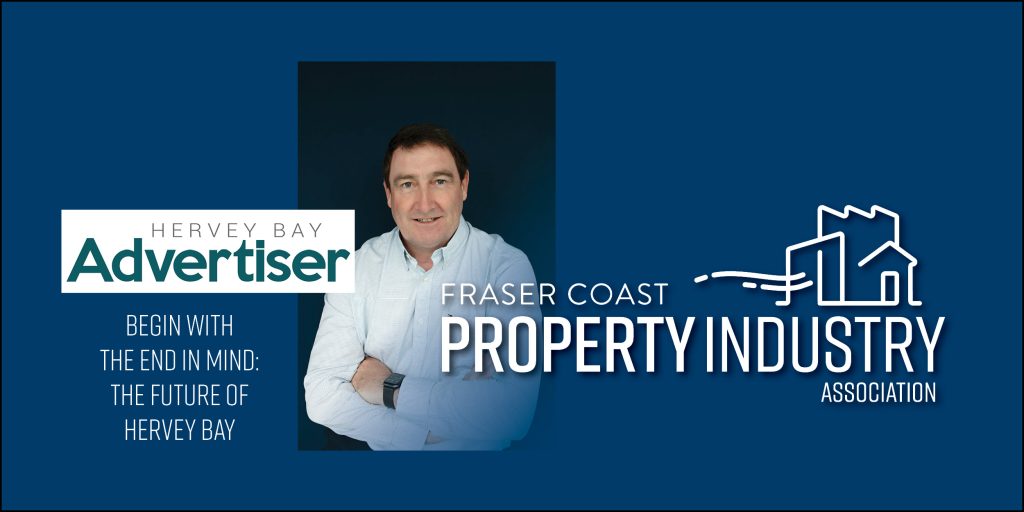
RECENTLY, one of Australia’s leading demographers, Simon Kuestenmacher from The Demographics Group, visited Hervey Bay. His presentation made it clear that our town needs to change direction. Currently, Hervey Bay has an aging population with an average age over 51. Over the next 20 years, this population will require high levels of care. Our current healthcare sector is already understaffed, and this situation will worsen as our workforce ages. To address this impending crisis, we must attract a younger population to Hervey Bay. This means offering education opportunities and training to retain young people, ensuring they can cater to our future needs. Traditional housing models do not appeal to younger generations; they seek alternatives in medium-density housing, along with a lifestyle that includes entertainment and career opportunities. Changing our direction involves rethinking our infrastructure, lifestyle opportunities, and even the culture of our city. We need to create an environment where young people want to live, work, and raise their families. This means improving marketing and promotion efforts to highlight the benefits of living in Hervey Bay. Our civic leaders must urgently replan for the future, targeting specific sectors of the Australian population to move here. By developing the right infrastructure and fostering a vibrant, youthful community, we can ensure that Hervey Bay thrives. Knowing what we want our future to look like is the first step in making it a reality. Let’s begin with the end in mind and act now to secure a prosperous future for Hervey Bay. Looking for more details on Simon Kuestenmacher ? Click here FCPIA is your dedicated property voice for the Fraser Coast… Join TODAY Click Here to Register
Fraser Coast future: booming population demands bold planning | 2 May 2024
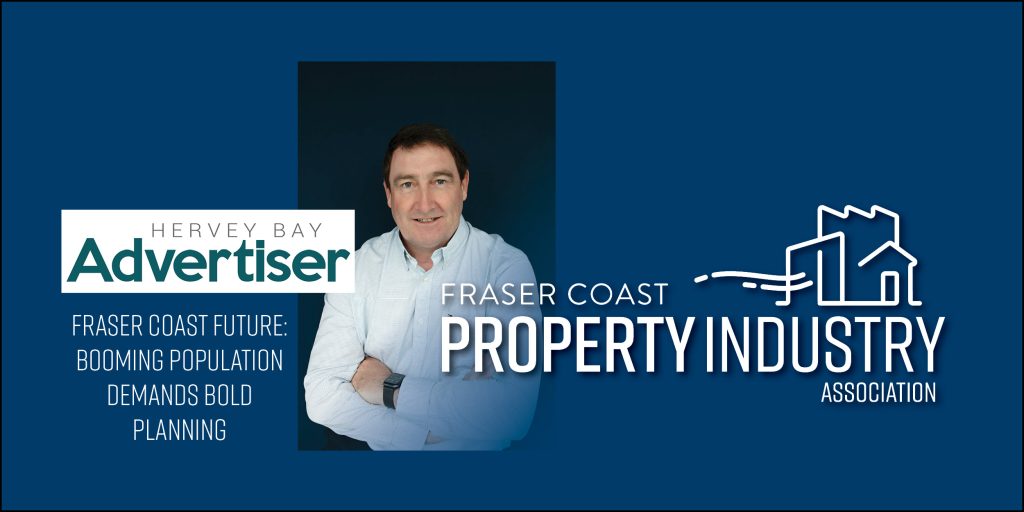
AS WE Navigate the post-COVID landscape, Fraser Coast is experiencing a transformative population boom. Pre-pandemic, our population stood at approximately 106,796. Fast forward just four years, and this number has surged to 118,505. With projections originally set for 130,706 by 2041, current trends suggest we could see numbers between 150,000 and 160,000 within 20 years. This rapid growth isn’t just a statistic; it’s a clarion call for urgent action. The average age in our community has increased from 48 to 51 years during the pandemic, indicating a shift towards an older demographic. This demographic shift requires us to rethink our housing strategy. Moving beyond traditional houses to more diverse living options that cater to an aging population. However, the most pressing challenge lies in our infrastructure. Current planning still relies on outdated pre-COVID growth figures, leaving essential services like health, roads, schools, sports, community facilities and town planning underprepared for the future. This oversight could significantly impact our quality of life and the economic vitality of the Fraser Coast. Moreover, we must address the exodus of our youth. As our brightest leave for opportunities elsewhere, our region risks stagnation. The recent decisions, such as the Scarness Caravan Park development, underscore a missed opportunity to create spaces that attract and retain young people. Blending local charm with modern attractions. It could have been a lagoon pool, nightlife and entertainment precinct, bustling with restaurants, parks and things to do for the younger generation. Instead we catered for the retired visitors. To secure a thriving future, we must embrace change. Innovate our approach to urban planning, and build a community that holds promise for all ages. The time to act is now, ensuring that Hervey Bay not only grows but thrives. Published in the Hervey Bay Advertiser 2 May 2024 Interested in the Fraser Coast Property Industry? Join FCPIA Today | Click here to join
Does the new Town Planning Scheme plan for AI? | 5 April 2024
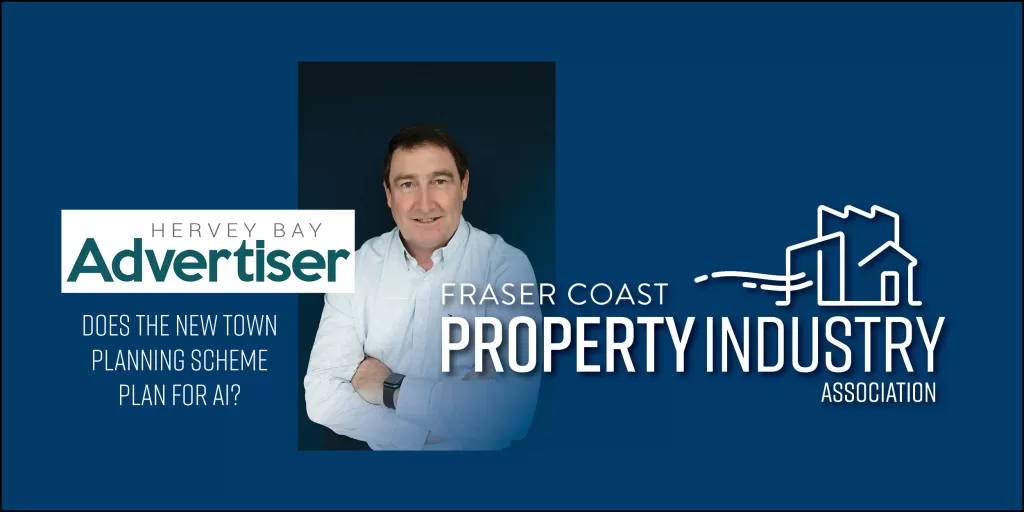
AS THE Fraser Coast Regional Council gears up to unveil its town planning scheme in 2025, a pivotal opportunity looms on the horizon—an opportunity to embrace the transformative wave of artificial intelligence (AI) that is set to redefine our future. With the plan poised to chart the region’s course over the next two decades, the absence of a strategy to integrate AI into the fabric of our community could be a glaring oversight. AI’s impact on society extends far beyond the realms of employment and electric and autonomous vehicles; it promises to revolutionise the very essence of community needs and public infrastructure. The traditional paradigms of city planning and living are on the brink of obsolescence. In less than a decade, the failure to adapt to these changes could render our current models irrelevant. Consider the potential of AI to streamline traffic management, making our roads safer and more efficient for autonomous vehicles. Imagine smart buildings that not only reduce energy consumption but also adapt to the changing needs of their inhabitants. Reflect on the power of AI to enhance public services, from predictive healthcare to personalised education, thereby elevating the quality of life for all residents. Moreover, the housing market is on the cusp of a revolution. The future demands flexible living spaces that can accommodate home offices, virtual reality entertainment areas, and more. Reflecting the shifting priorities of a digitally native population. The Fraser Coast Regional Council stands at a crossroads. By integrating AI into the new town planning scheme, it can lead the region into a future where technology and humanity converge to create a more sustainable, efficient, and inclusive community. The time to act is now; the future waits for no one. Let’s not just plan for the next 20 years; let’s envision a future that embraces the full potential of AI, ensuring the Fraser Coast remains at the forefront of innovation and progress. Published in the Hervey Bay Advertiser 4 April 2024 Interested in the Fraser Coast Property Industry? Join FCPIA Today | Click here to join
How Hervey Bay’s property market shapes our community

IN THE HEART of Hervey Bay, the property market stands not just as a sector of our economy, but as the very lifeblood of our community.
07/02/2024 Are Internet Trolls holding Hervey Bay back?

IN HERVEY Bay, the presence of internet trolls on social media platforms like Facebook, who vocally criticise every development, poses a significant challenge. These individuals, who can be likened to the Muppets’ characters Waldorf and Statler, are not only vocal but their actions have real consequences. Their negative and misleading commentary can adversely affect property prices and the perception of developers, creating hesitancy among potential investors. This results in long-term impacts on property valuations and impedes the city’s growth and development. Ironically, many of these trolls benefit from the very developments they oppose, living in local subdivisions and utilizing shopping centres, medical facilities, and other amenities, all made available through developers. Their stance is comparable to conspiracy theorists who criticise technology while using it themselves. Notably, a few of the more prolific attackers leading this charge are some older men who have been retired for many, many years and are obviously not worried about securing any opportunities for the youth of the area. The adage “Money is like water; it finds the path of least resistance” aptly describes the situation. If development in Hervey Bay becomes too burdensome due to opposition, investors will simply move their funds to more welcoming cities, helping them to prosper and leaving Hervey Bay lagging behind. The solution lies in the hands of the silent majority. It’s time for them to speak up against this negativity and advocate for a prosperous future for Hervey Bay, ensuring job opportunities and activities that retain the younger generation. Politicians, too, must focus on the greater good rather than being swayed by a vocal minority. In this election year, it’s crucial to support candidates who promote positivity and growth for the future of Hervey Bay.
11/01/2024 – 21 Storeys – Should we, or Shouldn’t we?

21 storeys – Should we, or shouldn’t we? THIS is the question raging around Hervey Bay at the moment. There are also a lot of mistruths and scare campaigns going on around the 21-storey application and the idea of going higher. FCPIA don’t advocate on individual applications, and I would like to throw some facts into the argument about going up. This is not necessarily specific to this development or height but to the benefit behind changing our thinking as a community. • Council has planned infrastructure for a minimum of 100 persons per hectare in high density nodes and we currently achieve nowhere near these figures on the Esplanade. Therefore, there would be no real cost of infrastructure upgrades. • There hasn’t been a new 6-storey building built since the GFC in 2008. The reason for this is that the current height limits are unviable for developers and high-end hotel chains to be sustainable. • Council already has 20-storey limits near the Marina and has passed 16 storeys in the CBD. So going up is not new and it will probably be part of Council’s new Town Planning Scheme. • Tourism is one of our biggest employers and attractions, and we are getting left behind the rest of Queensland. We haven’t had anything new of any real scale or quality for 15 years and the new tourism market demands quality if we are going to compete. • Our youth are leaving the area, and we lose around 1800 net in the 18-25 year olds per annum. We need new jobs created in tourism and hospitality, and 4-star plus resorts as one of the key employers are what’s required to keep our youth. These resorts will also keep the airlines flying into the region. • Housing is an issue and people moving here come for the water. So, we need diversity in apartment living for people to live, and high end, safe accommodation is needed in a variety of options. • Urban sprawl is adding to the cost of rates, causing environmental issues, and putting more cars on the road. Density with amenity around it is the only way to get that under control. • The Council Strategic Framework discusses projects like this and has the provision to go up so long as the project meets to desired outcomes. Therefore, any application should be accessed on its merits and dealt with by the professional town planners at Council, not individuals’ personal preferences. Let’s stop with the Facebook “the world is going to end” emotional campaigns and just look at the facts, benefits and issues and make reasonable urban town planning decisions on every application.
30/11/2023 – Fraser Coast is in the Shadows!

WHEN is the Fraser Coast going to get out of the shadows of the Wide Bay and really form its own identity as a region, like the Sunshine Coast? The Wide Bay as an entity disadvantages the Fraser Coast. We are always treated as the poor cousins when it comes to funding from government departments, and we are not seen as the major growth area even though Hervey Bay will be the biggest city in the Wide Bay. It’s time we start trading on the “Fraser Coast” entity that lines up with our council boundaries and fight for infrastructure for the Fraser Coast. The recent Wide Bay Plan by the State Government was a disgrace. It was Bundaberg-centric and completely overlooked the Fraser Coast for key infrastructure. Even when industry and Council complained about this, it fell on deaf ears in State Government. We have a Wide Bay Health Board, again Bundaberg-centric and focusing on future hospitals up there even though we have an aging population and faster growth rates here. We should have a Fraser Coast Health Board. Our Federal Members are based in Bundaberg and Maryborough and are conflicted representing four major cities of which two sit outside the Fraser Coast. Why don’t we have one Federal Member for the Fraser Coast? The Main Roads Department sits in Bundaberg and has done the planning for that area but is years behind on road infrastructure on the Fraser Coast. The list goes on of key government departments that sit outside the Fraser Coast but are supposed to be representing our interests. The Fraser Coast, and in particular Hervey Bay, will be the major city in the Wide Bay over the next 20 years. We need Fraser Coast representation, and we need to promote our area as a destination like our tourism does.
02/11/2023 Should Politicians focus on infrastructure?

AFTER a failed “Voice” campaign incurring over $450Mil in costs and months of distraction from the key issues affecting the majority of the population, you must ask what our politicians’ priorities are.You would think infrastructure and the cost of living and housing should be up there as key priorities.In Queensland, we have State and Council elections coming up in 2024.Imagine spending that $450 million on infrastructure.That could have been over 740 social homes built locally, the Tiaro Bypass, a Level 5 Hospital, a convention centre or sporting facilities for the next 20 years.We need to see the focus back on our community’s infrastructure projects.I would like to see every politician or want-to-be politician come up with their top ten priority infrastructure projects that they want to happen in the Fraser Coast.That way everyone knows what they stand for and the choices become clearer at election time. It will also make politicians accountable during their term if elected.This is a simple model, with no spin or feel good, warm, fuzzy statements, just tangible projects that will benefit the community.For private development and the building industry to keep growing, we need public infrastructure to service the demands of the growing population, increased traffic, recreation, education, community etc.Let’s get the politicians to tell us what their vision is for the Fraser Coast.Will they freehold the marina, expand the hospital precinct, enhance the Esplanade, expand the sports precinct, redevelop the CBD’s, expand the airport flights and capacity or expand the industrial precinct in Maryborough?We also need water, roads, sewerage, and other enhancements, to cater for the growth.We are just letting the growth occur without the infrastructure to support it.I want to know what the next group of politicians have as their vision if they are putting their hand up for office.Let’s become bold, visionary, positive and progressive and elect the politicians that have the clearest and best vision for our future that the population wants.As John Quincy Adams once said, “If your actions inspire others to dream more, learn more, do more and become more, you are a Leader.”
05/10/2023 Is the Face of Hervey Bay Changing
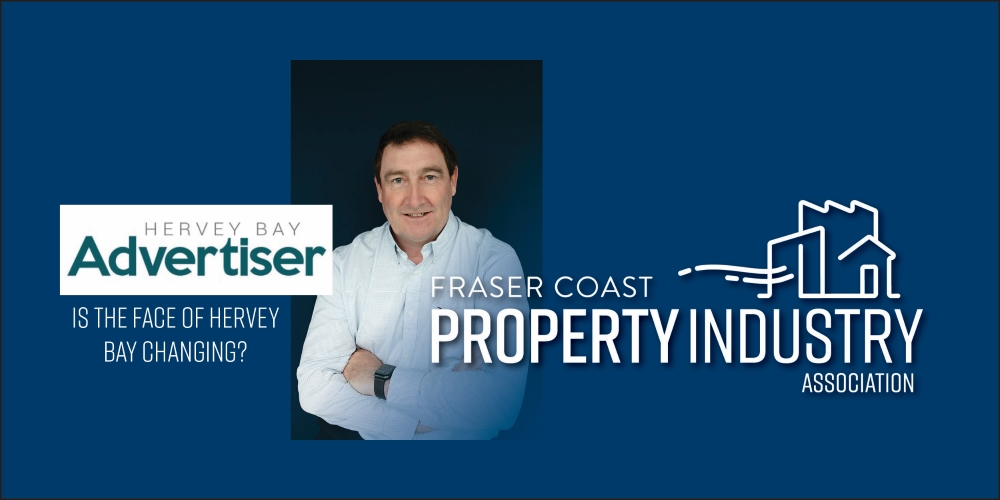
07/09/2023 – Is The Residential Market Still Strong?

05/05/2022- Do Elections Impact The Property Market?

04/04/22 Experts shoot down claims Wide Bay property market has stalled
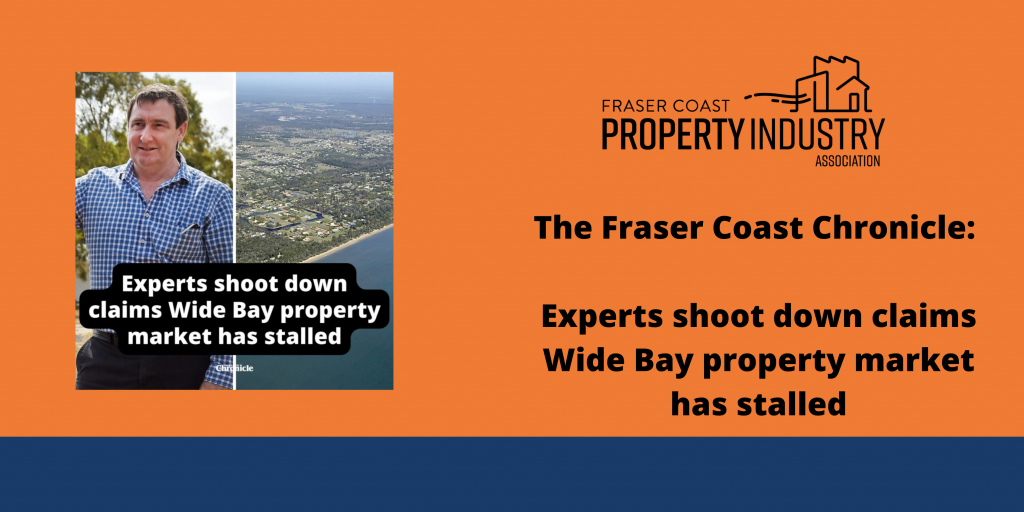
Glen Winney says Fraser Coast, Bundaberg, Gympie property markets strong New REA Group data has revealed 113 of Queensland’s 775 towns and suburbs experienced a fall in median house prices since hitting their peak. Eight of these were in the Wide Bay. Home hunters looking for a unit in the Wide Bay will have to dig deep thanks to a scorching hot market revealed as Queensland’s best. Real estate industry leaders have shot down suggestions the scorching hot property market across Gympie, the Fraser Coast and Bundaberg has begun to stall despite some suburbs experiencing a slump in sale prices. New REA Group data has revealed 113 of Queensland’s 775 towns and suburbs experienced a fall in median house prices since hitting their peak. Eight of these were in the Wide Bay. Branyan, on the outskirts of Bundaberg, recorded the largest slide from its peak median price, down to $400,000 compared to the $427,500 median price that houses were selling for in April 2021. This was a drop of 6.4 per cent. Childers had the second largest drop at 3.1 per cent, with houses now selling for an average of $265,000, $8000 less than they were being snapped up for in March 2021. The median house price at Childers was down 3.1 per cent from its March 2021 peak of $273,000, according to the latest REA Group data. Bundaberg East was the only other suburb around the Rum City to experience a drop. Four Fraser Coast towns experienced a similar price slip: Burrum Heads, Granville, Dundowran Beach and Aldershot, which dropped a sliver from $259,000 in January 2022 to $258,500. Goomeri was the only Gympie region town to drop in price, from $213,000 in December 2021 to $210,000. Fraser Coast Property Industry Association president Glen Winney said the market had steadied compared to how it was at Christmas, but prices had not dropped. “It’s more of a stock issue than anything else,” Mr Winney said. Fraser Coast property Industry Association president Glenn Winney said the market had steadied, but this was more because of stock issues than anything else. Outside factors like interest rates and inflation “will try to slow the market,” he said. But there was still 12-18 months of demand for new housing across the Fraser Coast, and this would continue to drive the market. When that interest trailed off the market might slow some at the end of 2022, but Mr Winney said the capital cities would feel the effect before regional areas did. First National Real Estate Childers’ partner David Carlon said any suggestion the market was starting to decline was “rubbish”. Mr Carlon said inquiries had “eased off a bit” in the past few weeks but still expected prices to continue rising for the next year. There was nothing specific he could attribute that slow-down too, he said. But the market surge across regional areas did not have a clear reason either given Childers had not had any increase in the number of available jobs or new services. “I’ve been in the industry for 30 years and I don’t understand the market at all at the moment,” Mr Carlon said.
24/03/22 How to navigate the boom-bust property cycle
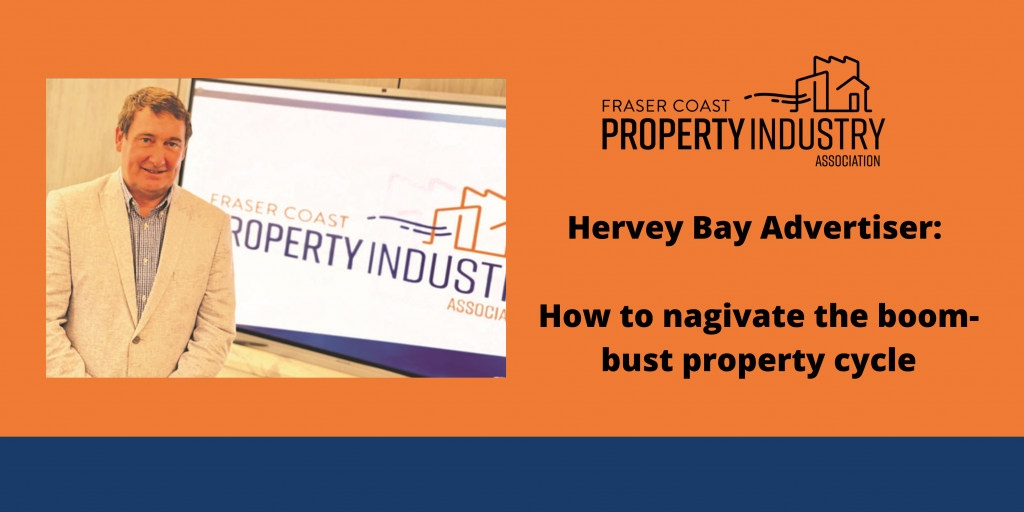
24/02/2022 The Hervey Bay Property Market Post COVID
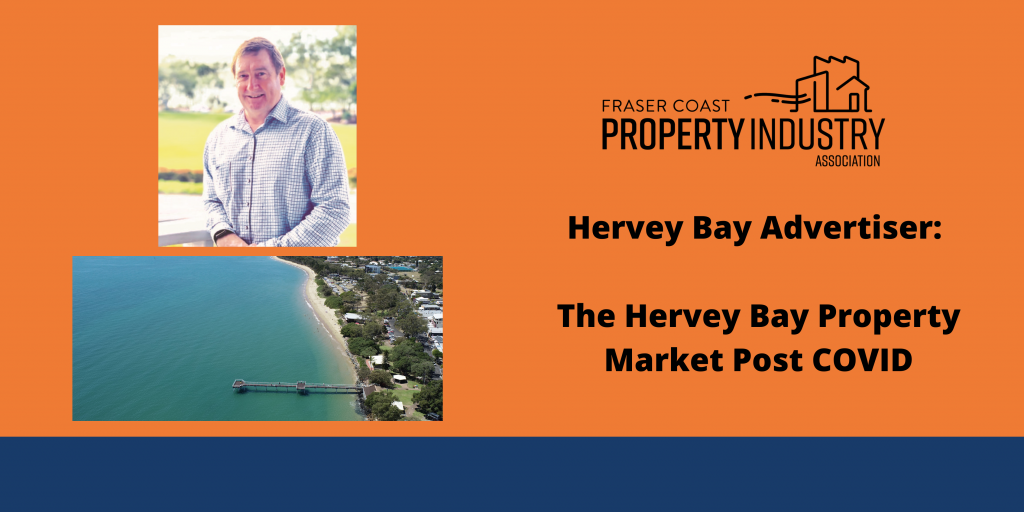
21/10/2021- FCPIA Zoom Forum with Tom Tate Recording
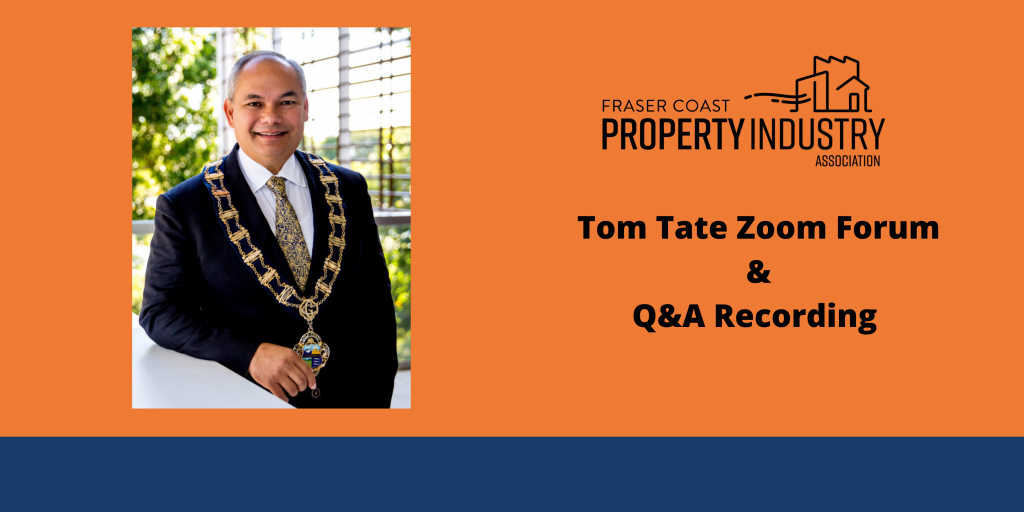
07/10/2021 Hervey Bay CBD Masterplan maps out twenty years
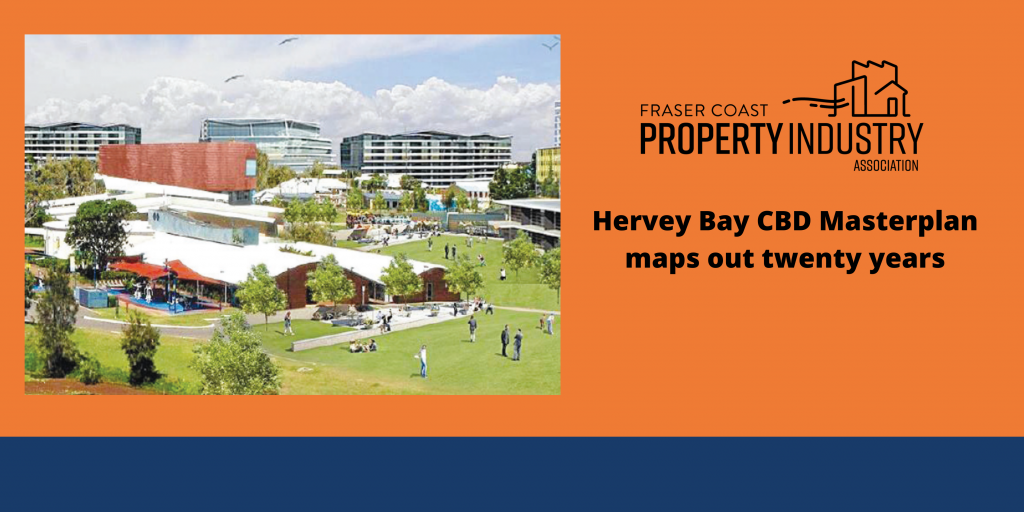
23/09/2021 Once in a generation property boom shows no signs of slowing
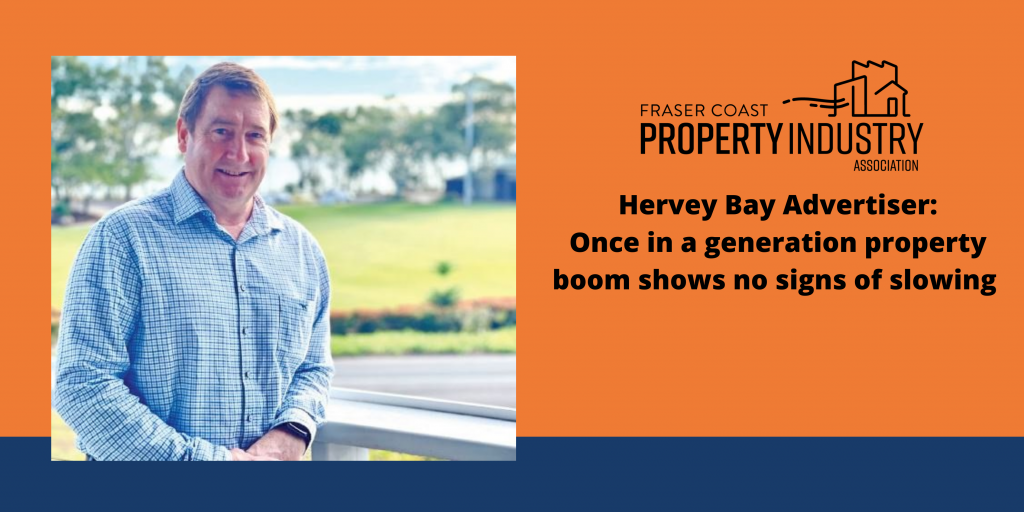
01/09/2021 Fraser Coast Property Industry Association Forum Recording – Guest Speaker Terry Ryder
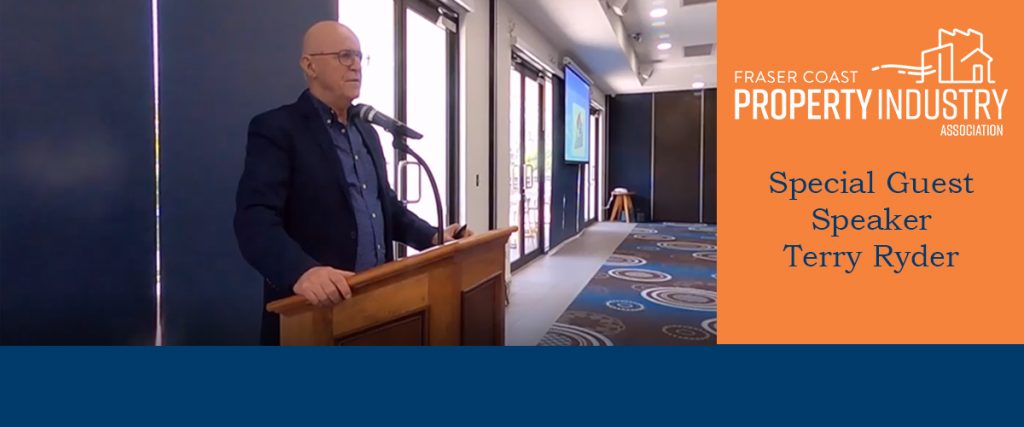
11/08/2021 This bubble isn’t bursting anytime soon
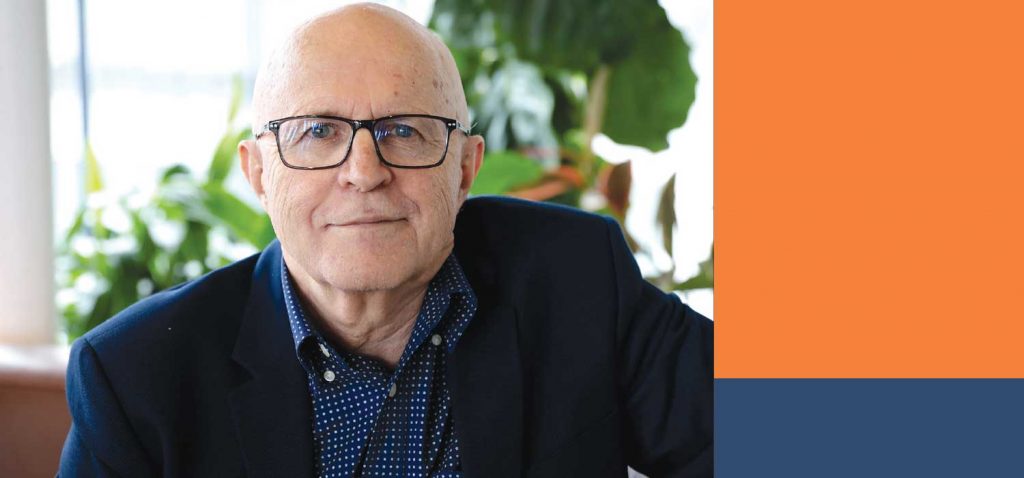
Source Hervey Bay Advertiser and Hervey Bay Property Guide
Published on Aug 11 2021
12/08/2021 Property Boom is official
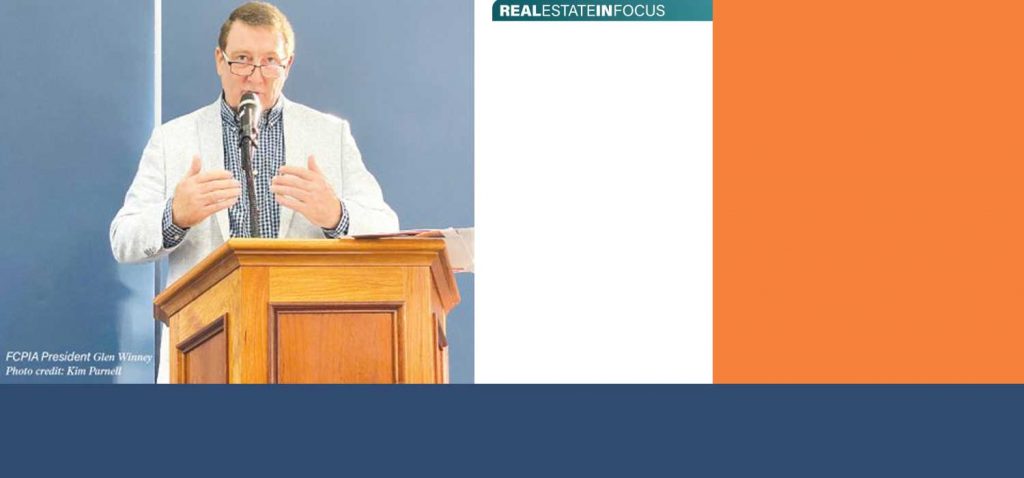
25/03/2021 Fraser Coast Property Industry Association Forum Recording
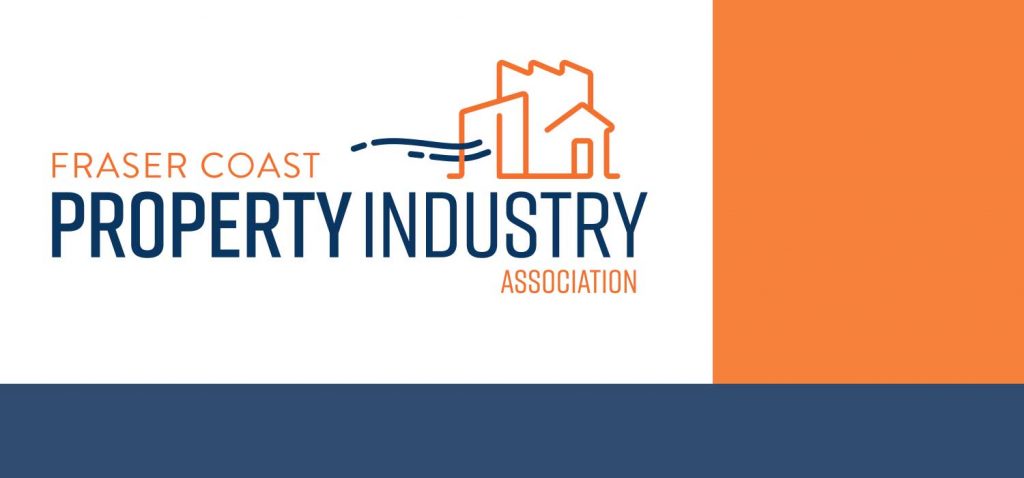
Watch the Recording of the Forum
24/03/2021 7 News reporting on the Fraser Coast Property Forum
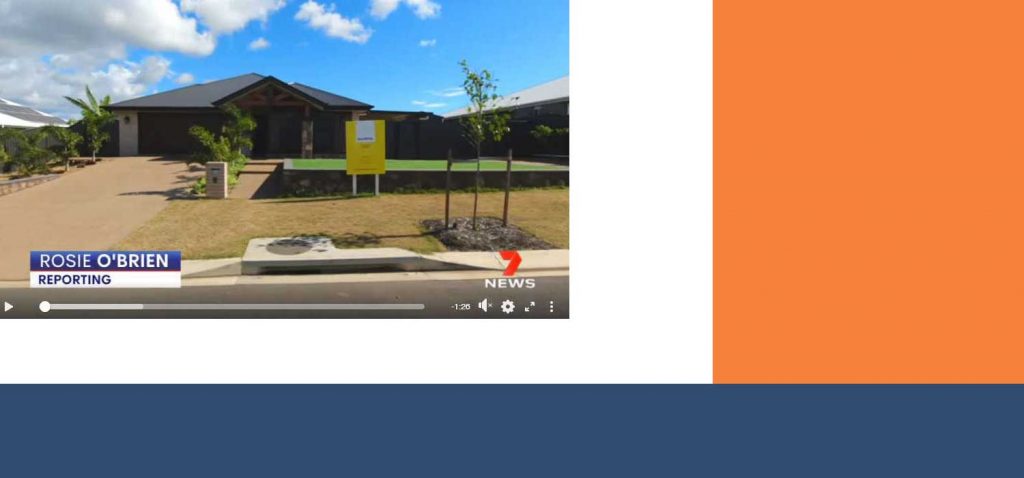
Rosie O’Brien Reporting
24/03/2021 Fraser Coast Property Forum Photos
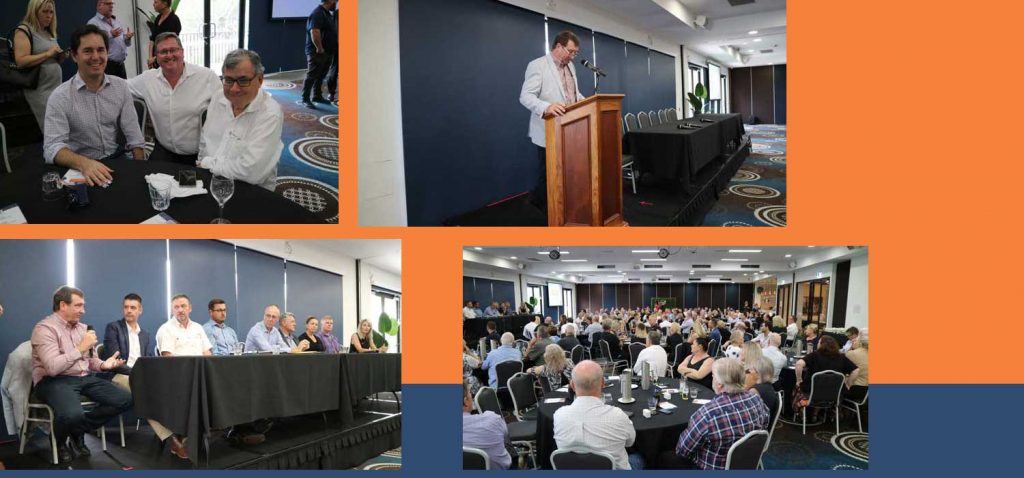
Photos from the event
10/03/2021 This boom’s different

Source Fraser Coast Chronicle March 10th 2021
09/03/2021 Fraser Coast Property Experts Join Forces
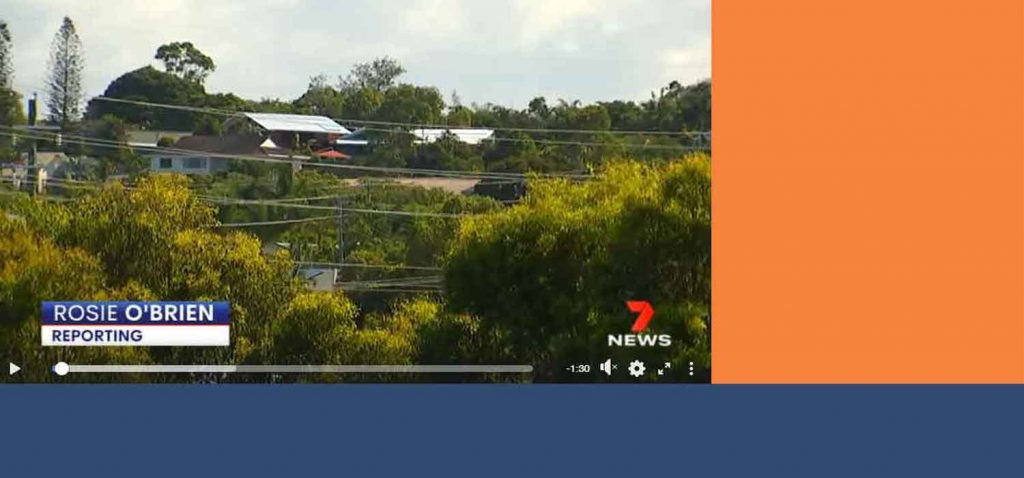
Source 7 News Wide Bay Network 09th March 2021
08/03/2021 Wide Bay Property Boom

03/08/2021 Coasts Peak Property Powerhouse chooses chief
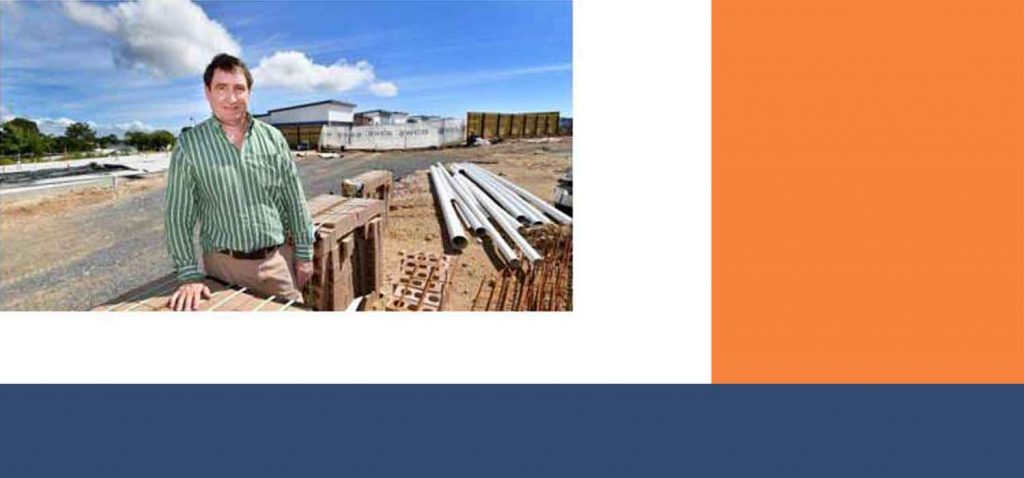
22/07/2020 Grant to Deliver Millions

16/07/2020 Building Hope
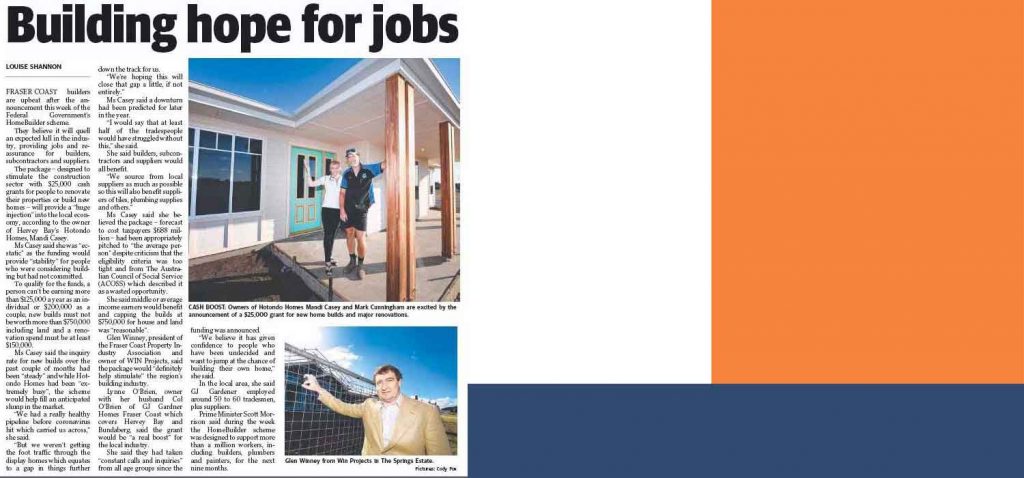
23/04/2020 Safe as Houses
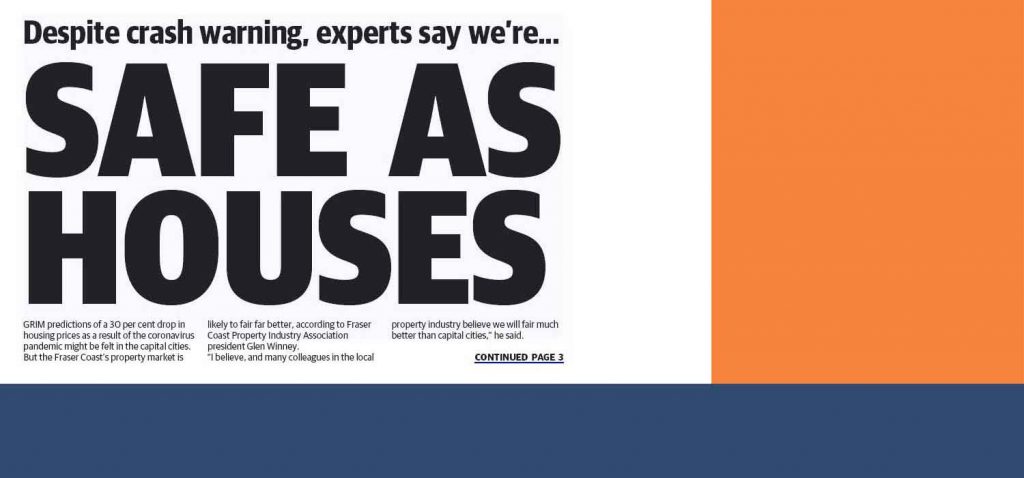
Fraser Coast Chronicle Friday May 15th 2020
25/03/2020 Property Group has first event
